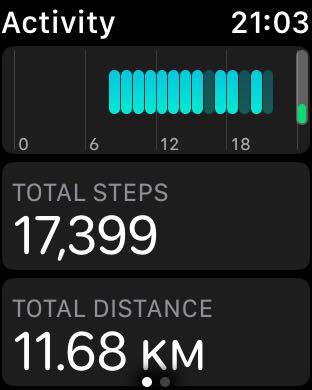Today we had planned a drive/walking tour of Kiev. After yesterday’s super long day out to Chernobyl and the way my back was feeling, I was doubting the sanity of lining up for another long day out. This morning my back is still not back down to its usual dull roar, but we only have limited time, I just have to push on and hopefully not pull the pin too early. Seriously, I really need a sea day!
Monument to Kyiv, Shchek and Khoryv, the are three legendary brothers, often mentioned along with their sister Lybid who are believed to be the founders of the medieval city of Kyiv. According to legend, Kyiv, the eldest brother, was a prince from Polonia and he named the city after himself. There are also mountains named after his brothers and a river named after Lybid around here somewhere.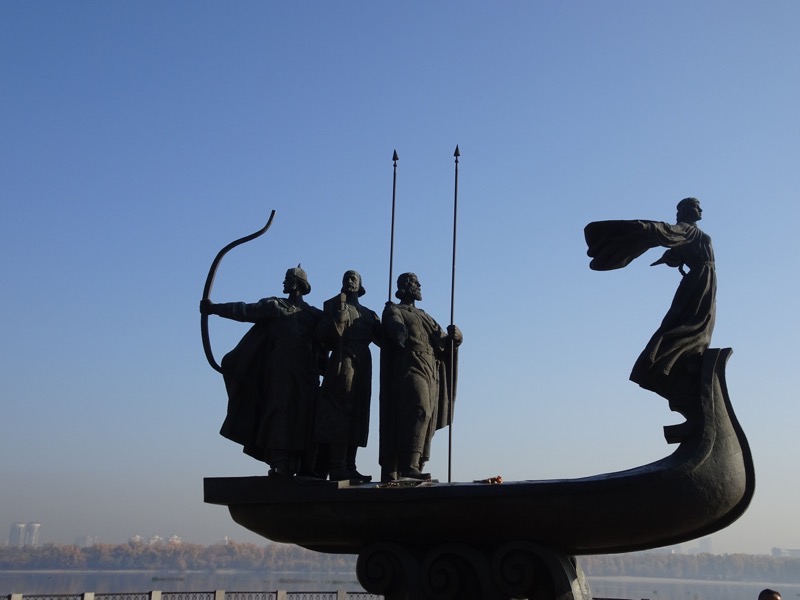 Bridal couples like to visit this monument and turn their back to the longship throwing their bouquets onto the ship – if the flowers land on the deck of the ship, they wll have a long and happy marriage.
Bridal couples like to visit this monument and turn their back to the longship throwing their bouquets onto the ship – if the flowers land on the deck of the ship, they wll have a long and happy marriage.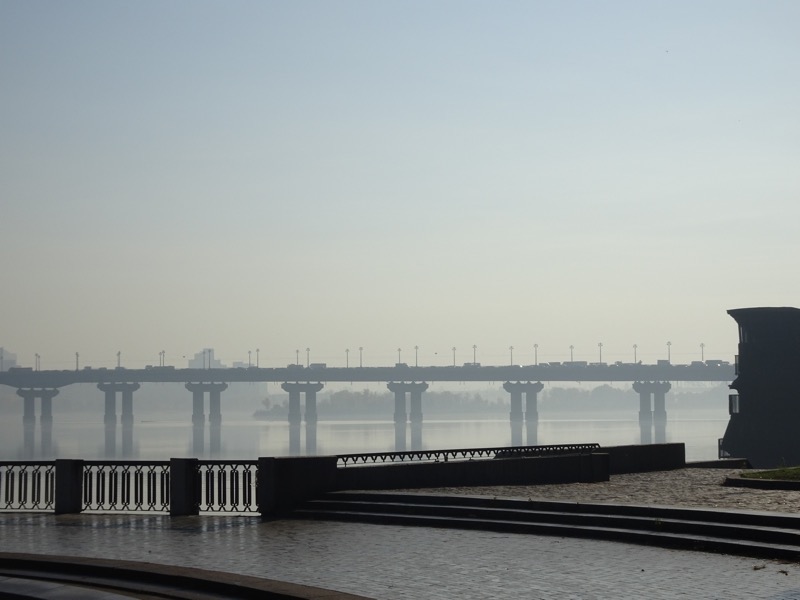 This is called the ‘Tree of Happiness’ and it is full of ribbons and tokens placed here from the parents of the aforemented bridal couples.
This is called the ‘Tree of Happiness’ and it is full of ribbons and tokens placed here from the parents of the aforemented bridal couples.
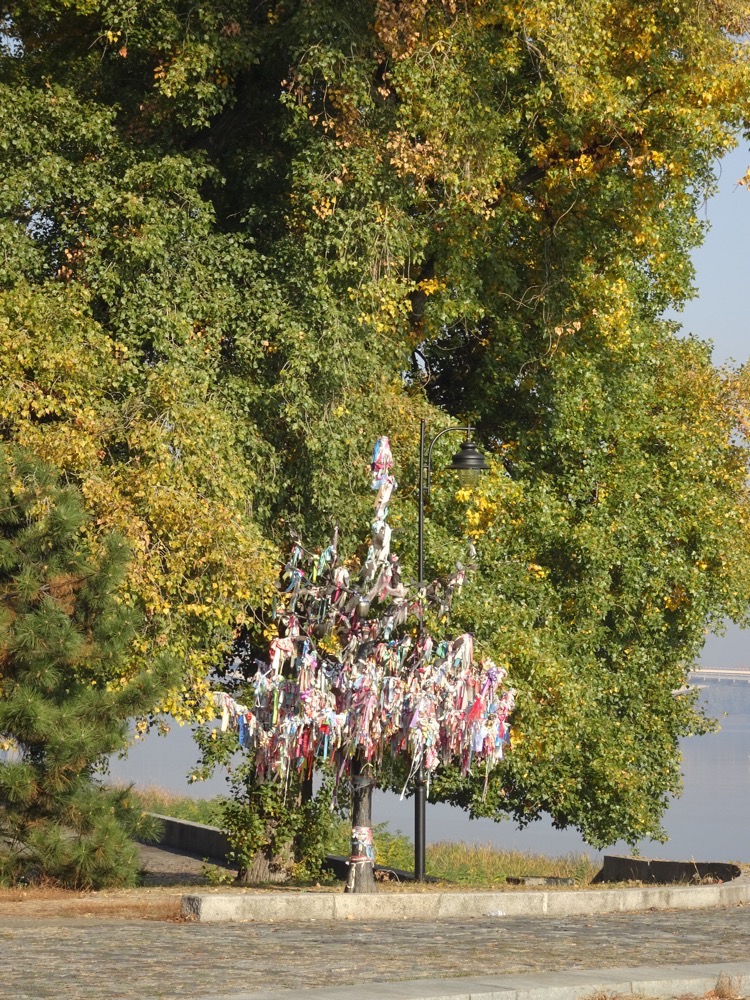
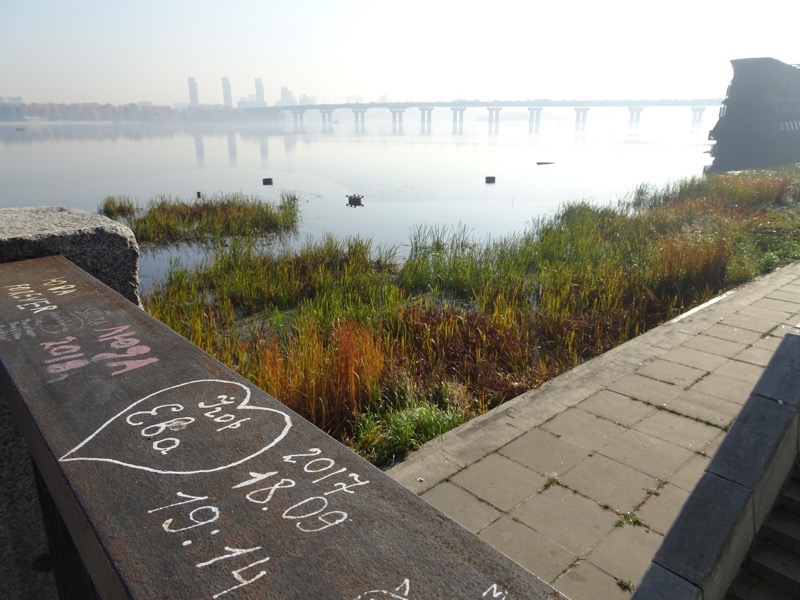
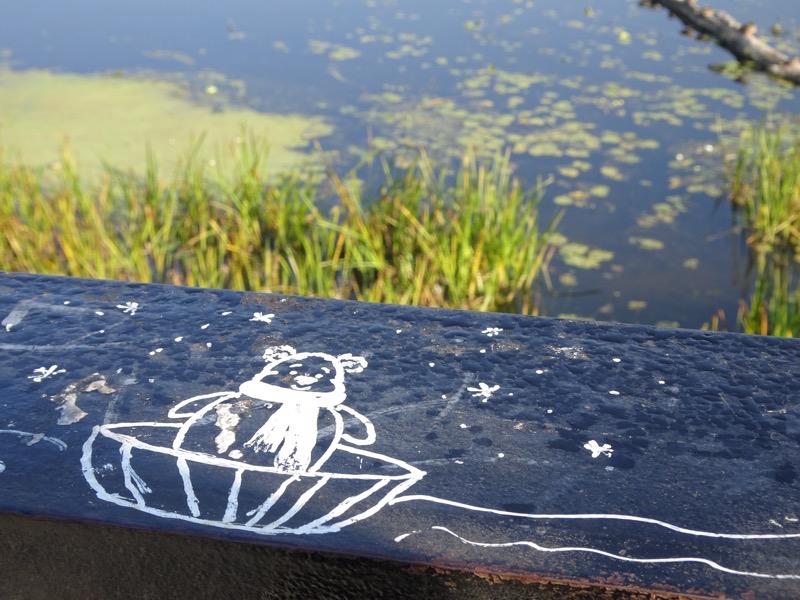 Banks of the Dneiper River.
Banks of the Dneiper River.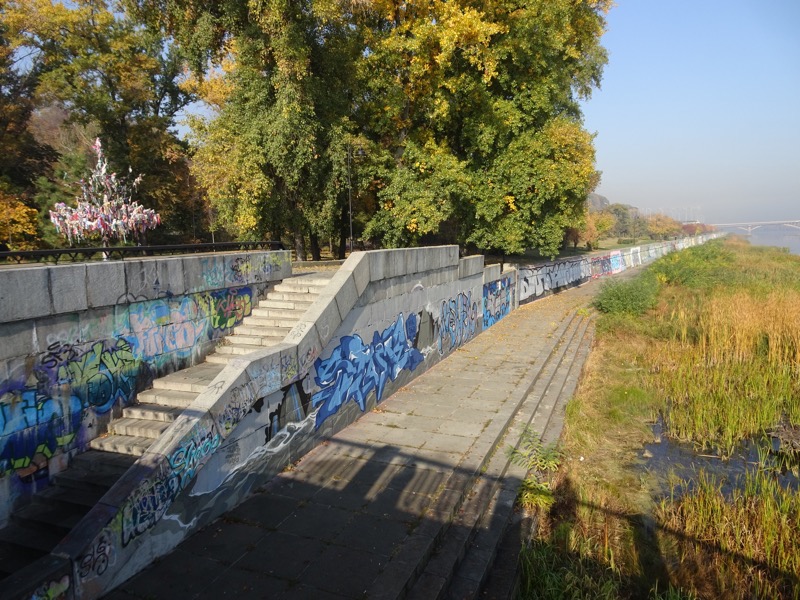 The Motherland Monument stands high on the hills over the Dnieper River and is a part of the Ukraine World War II Museum – it is the only remaining monument in Ukraine bearing Soviet imagery, and the reason is that no one can decide how/what to replace it with. At 102m tall, it is an imposing structure designed to convey the power and strength of the Soviet Union.
The Motherland Monument stands high on the hills over the Dnieper River and is a part of the Ukraine World War II Museum – it is the only remaining monument in Ukraine bearing Soviet imagery, and the reason is that no one can decide how/what to replace it with. At 102m tall, it is an imposing structure designed to convey the power and strength of the Soviet Union.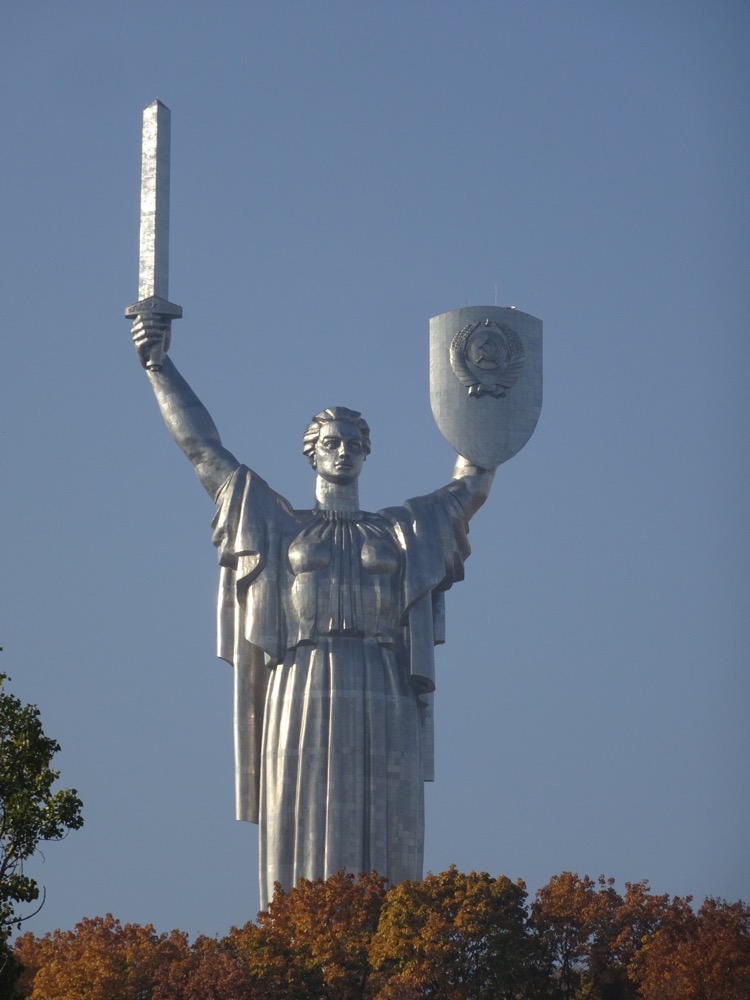 The WWII Musuem is lined with tanks and helicopters, many of which are from the 1980s wars with Afghanistan. Thanks Charlie Wilson – Ukraine has plenty of young vets with PTSD.
The WWII Musuem is lined with tanks and helicopters, many of which are from the 1980s wars with Afghanistan. Thanks Charlie Wilson – Ukraine has plenty of young vets with PTSD.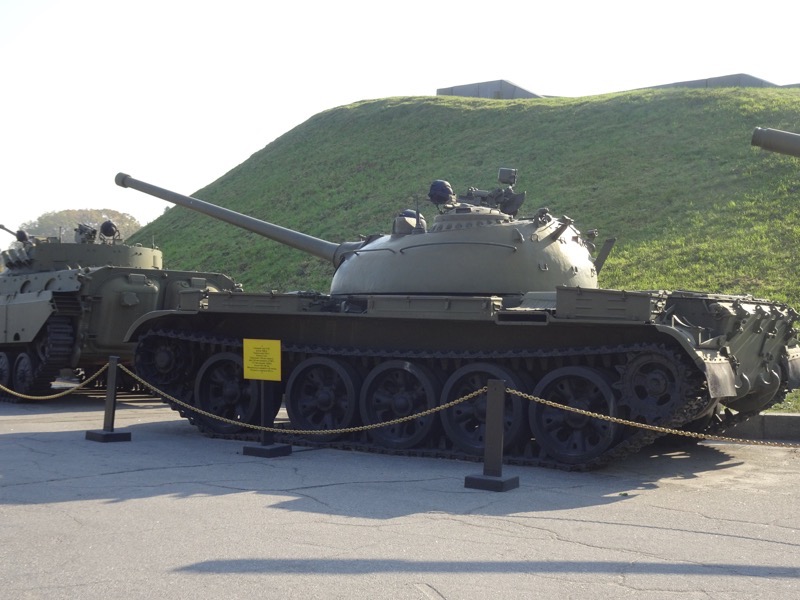 Our next stop was the National “Holodomor Victims Memorial”. The Holodomor (literally “to kill by starvation”) of 1932-1933 was effectively the Ukraine’s version of the Halocaust. It was a man-made famine in Soviet Ukraine that killed millions of Ukrainians. The museum was opened on the day of the 75th anniversary of the Holodomor in 2008 and gained the status of a national museum in 2010. The museum is located on the Pechersk Hills on the right bank of the Dnieper river in Kiev, adjacent to the Kiev Pechersk Lavra.
Our next stop was the National “Holodomor Victims Memorial”. The Holodomor (literally “to kill by starvation”) of 1932-1933 was effectively the Ukraine’s version of the Halocaust. It was a man-made famine in Soviet Ukraine that killed millions of Ukrainians. The museum was opened on the day of the 75th anniversary of the Holodomor in 2008 and gained the status of a national museum in 2010. The museum is located on the Pechersk Hills on the right bank of the Dnieper river in Kiev, adjacent to the Kiev Pechersk Lavra.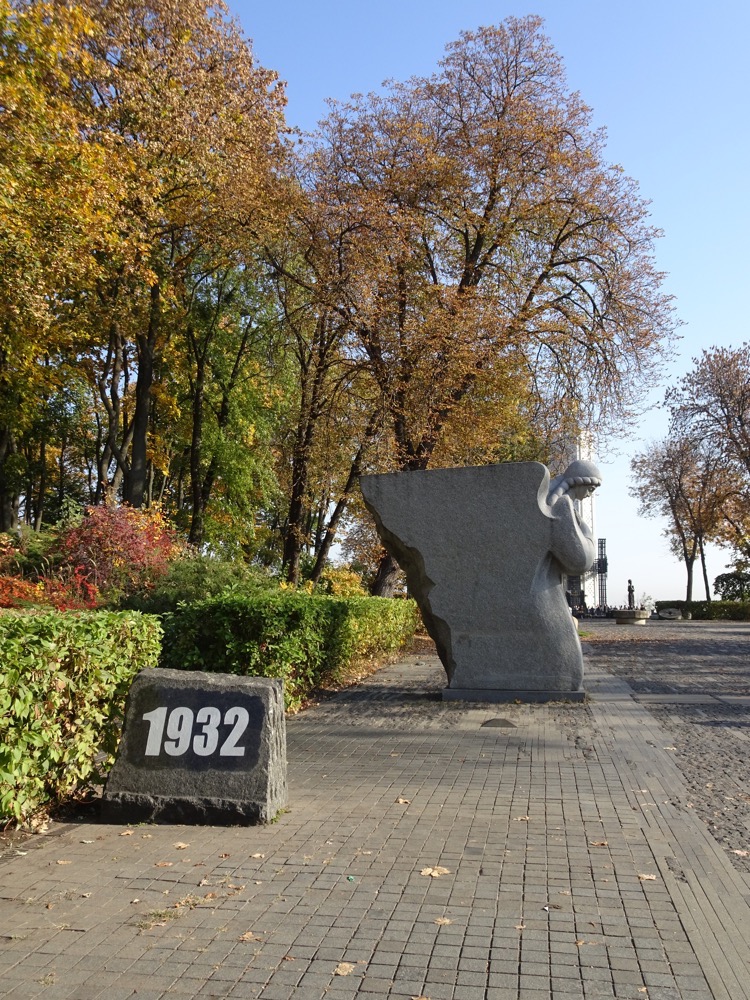
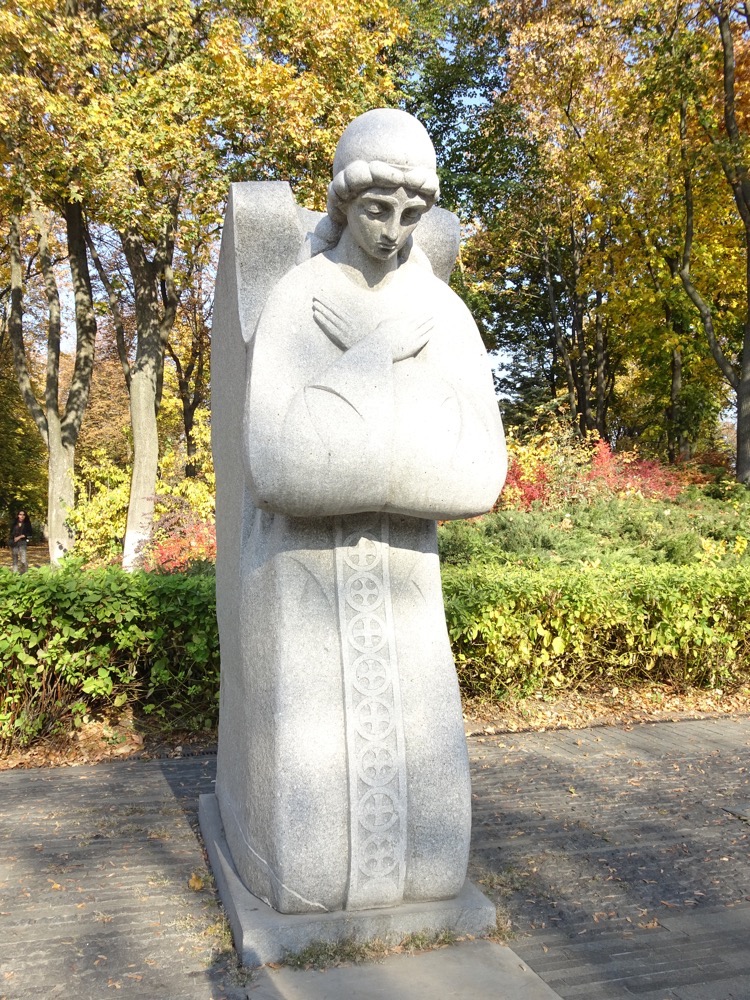 During the Holodomor, millions of inhabitants of Ukraine, the majority of whom were ethnic Ukrainians, died of starvation in an unprecedented, deliberate and orchestrated famine that was carried out against the Ukranian people by the Soviet Government. Fatalities are uncertain, but up to 12 million ethnic Ukrainians were said to have died as a result of the famine.
During the Holodomor, millions of inhabitants of Ukraine, the majority of whom were ethnic Ukrainians, died of starvation in an unprecedented, deliberate and orchestrated famine that was carried out against the Ukranian people by the Soviet Government. Fatalities are uncertain, but up to 12 million ethnic Ukrainians were said to have died as a result of the famine.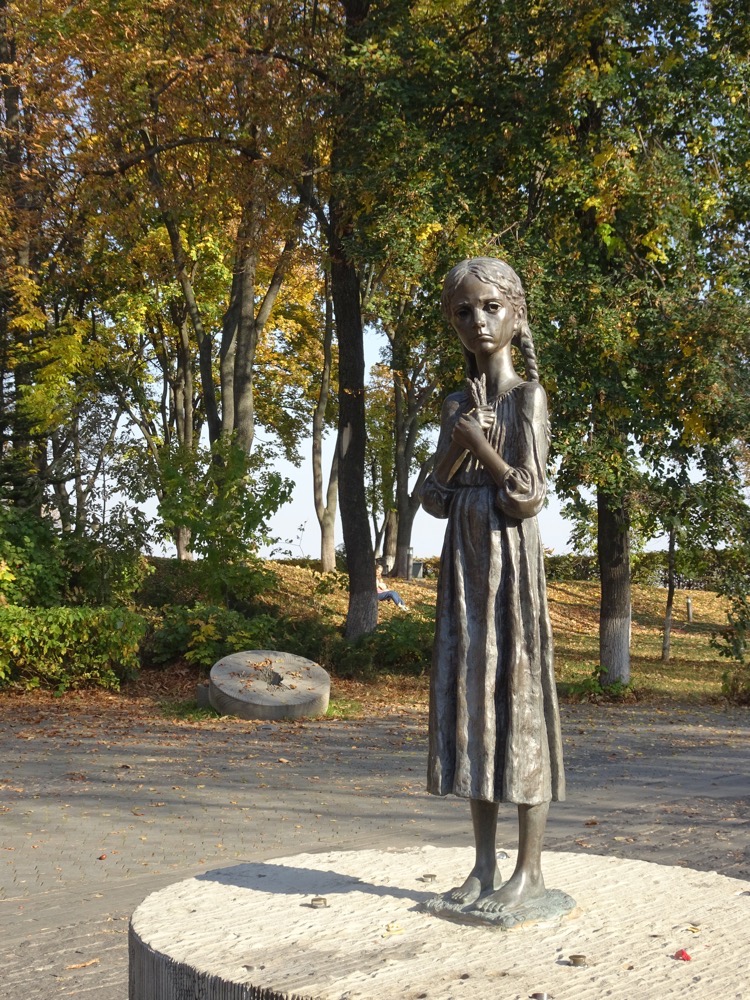 As it was explained to us, the Soviet Union has always tried to subjugate the ethnic Ukrainians and this famine was an effort to try and ‘eradicate’ the region of the Ukrainians altogether. Children as young as 12 would be jailed for possessing more than five stalks of grain, foodstuffs were confiscated allegedly for military efforts, and people became so desperate that evidence of widespread cannibalism (literally thousands of people resorted to eating people) was documented during the Holodomor, with children quite commonly ending up victims.
As it was explained to us, the Soviet Union has always tried to subjugate the ethnic Ukrainians and this famine was an effort to try and ‘eradicate’ the region of the Ukrainians altogether. Children as young as 12 would be jailed for possessing more than five stalks of grain, foodstuffs were confiscated allegedly for military efforts, and people became so desperate that evidence of widespread cannibalism (literally thousands of people resorted to eating people) was documented during the Holodomor, with children quite commonly ending up victims.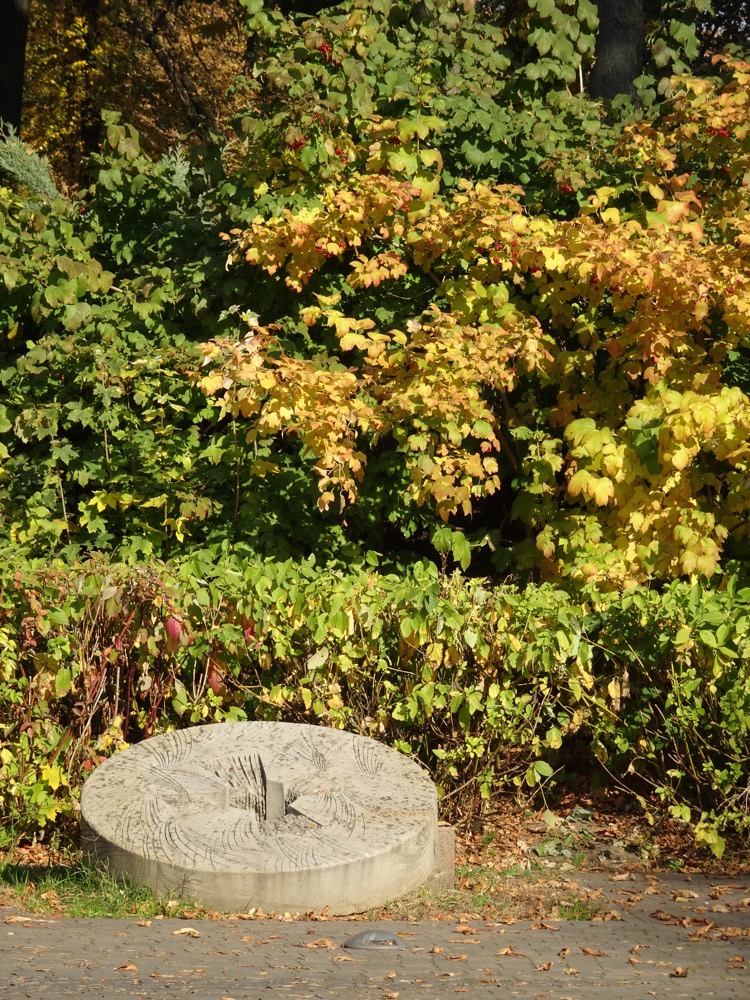
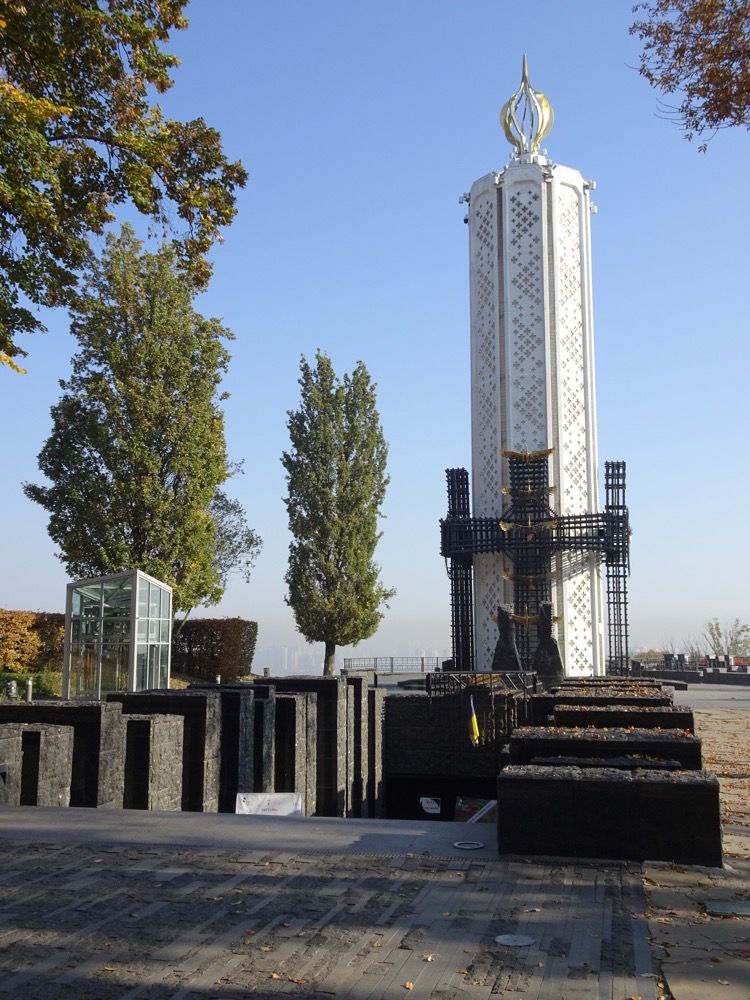
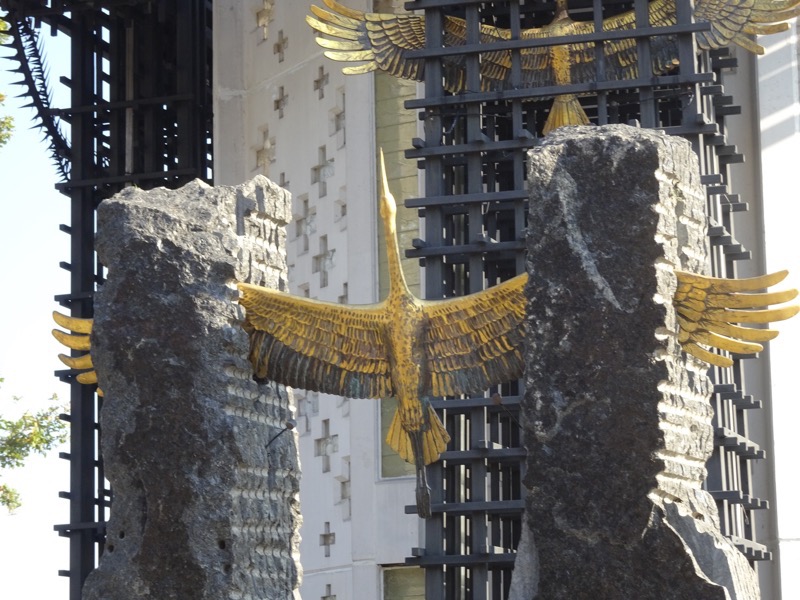
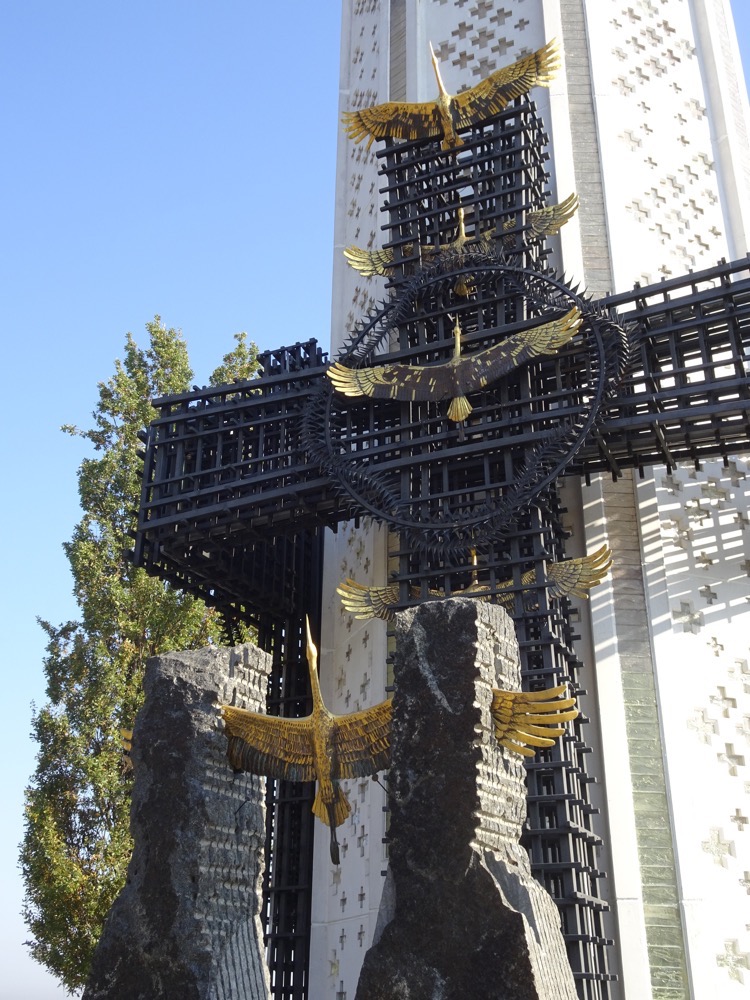
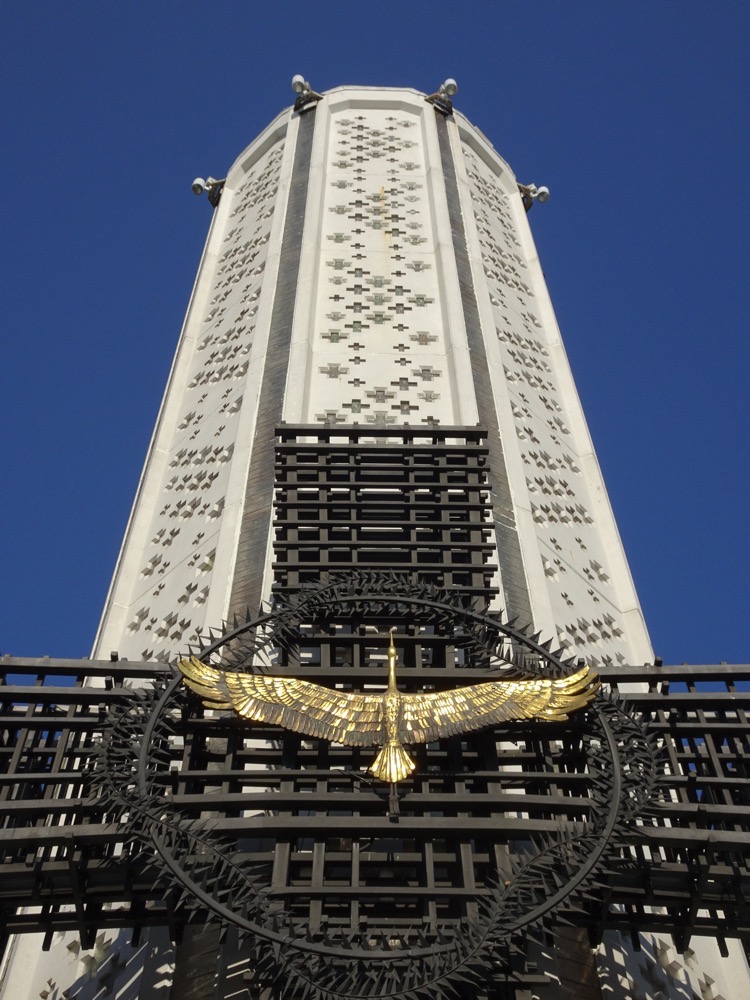 The World War II obelisk and to the right, what was designed and built to be a ‘youth skating rink centre’ but by the time corruption and government was through with it, it opened as a bar for diplomats with topless waitresses on roller skates. :/
The World War II obelisk and to the right, what was designed and built to be a ‘youth skating rink centre’ but by the time corruption and government was through with it, it opened as a bar for diplomats with topless waitresses on roller skates. :/ 
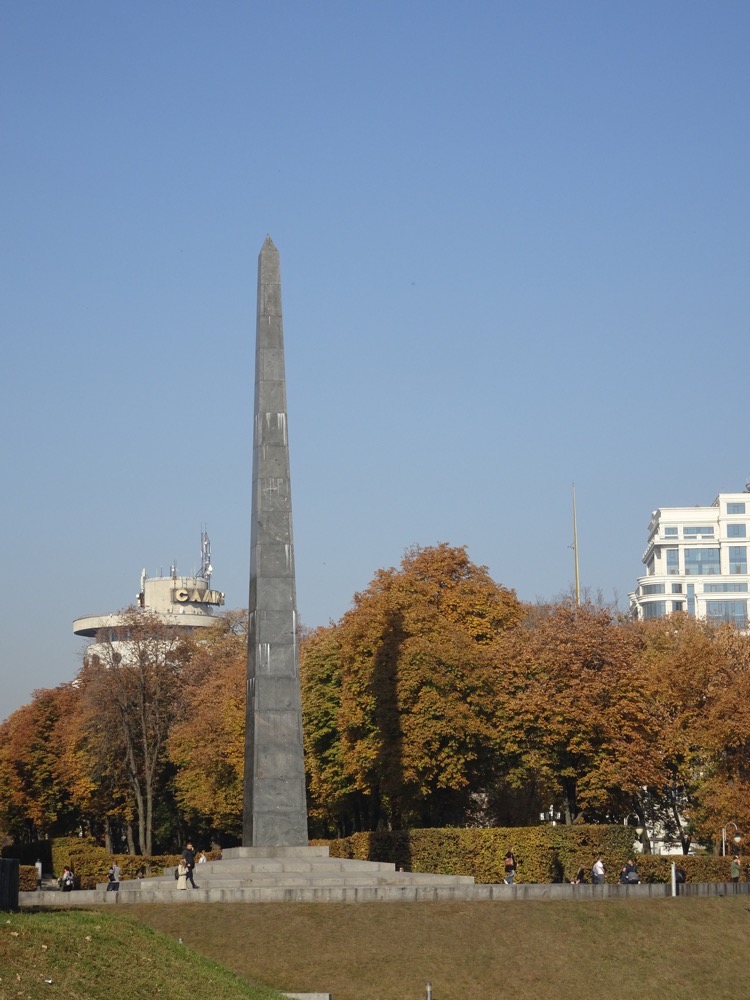 Kalyna berries are one of the national symbols of Ukraine. The red fiery colour of the berries represents beauty in Russian and Ukrainian culture and they symbolise the passionate love of a beautiful woman. They are seen quite commonly in folk painting and embroidery designs, and are used in decorations at holidays and weddings etc.
Kalyna berries are one of the national symbols of Ukraine. The red fiery colour of the berries represents beauty in Russian and Ukrainian culture and they symbolise the passionate love of a beautiful woman. They are seen quite commonly in folk painting and embroidery designs, and are used in decorations at holidays and weddings etc.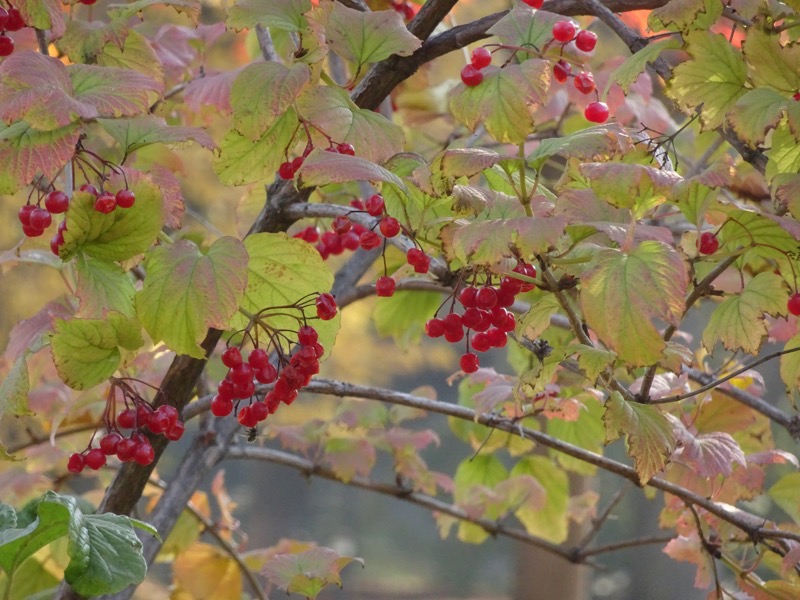
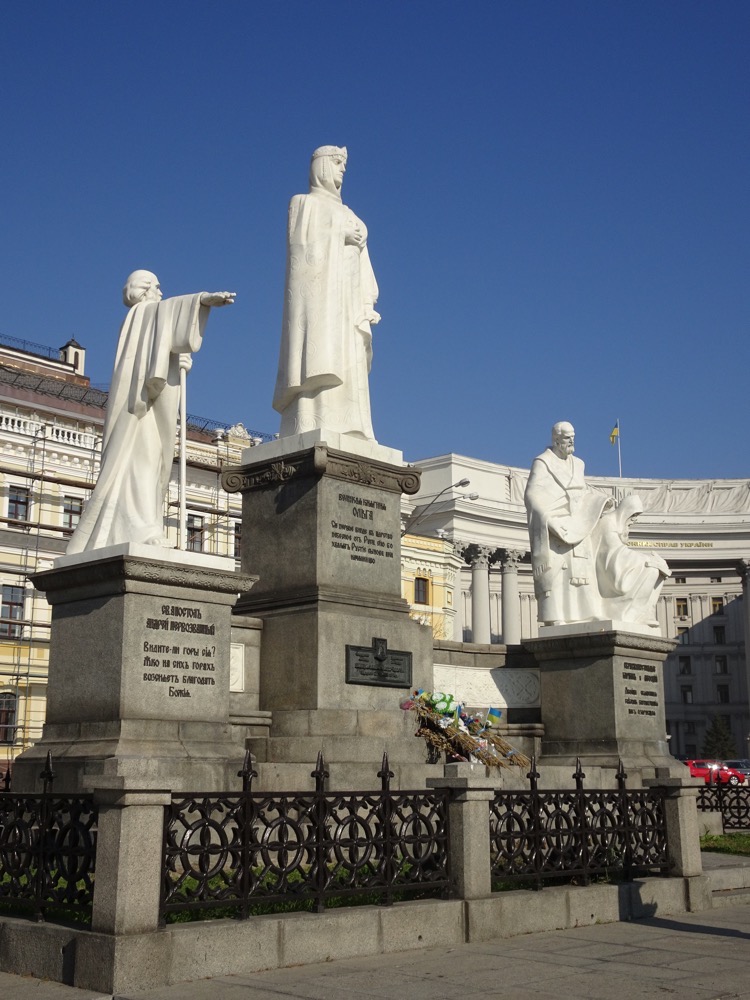
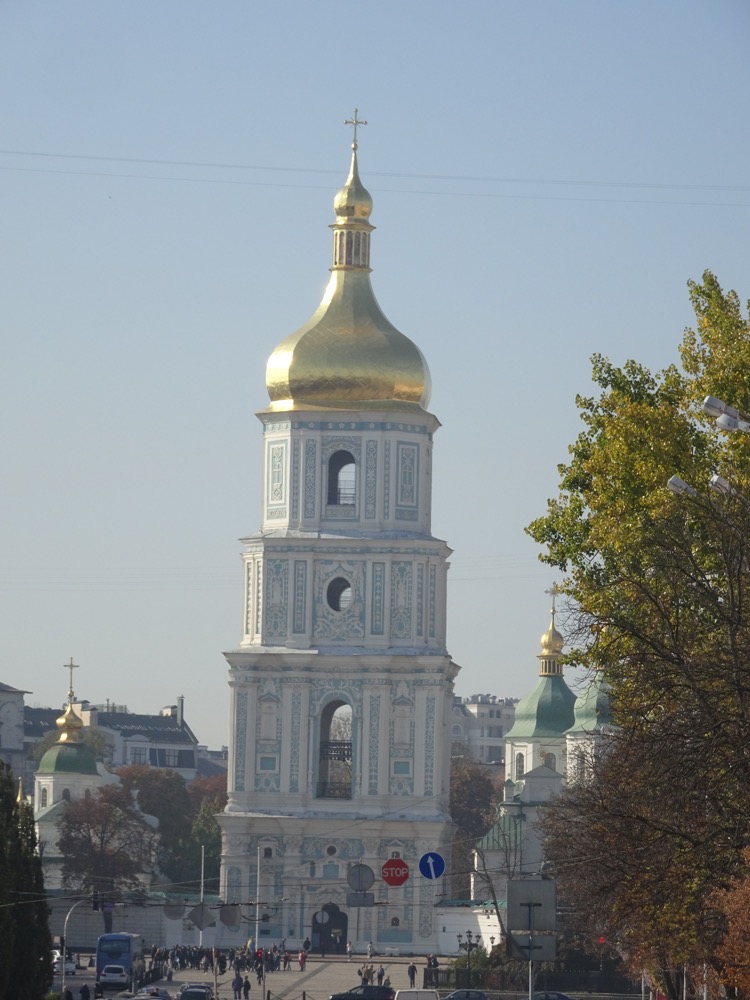 Somewhat incongruously, right beside the impressive St Michael’s Monastery sits the official Department of Foreign Affairs building.
Somewhat incongruously, right beside the impressive St Michael’s Monastery sits the official Department of Foreign Affairs building.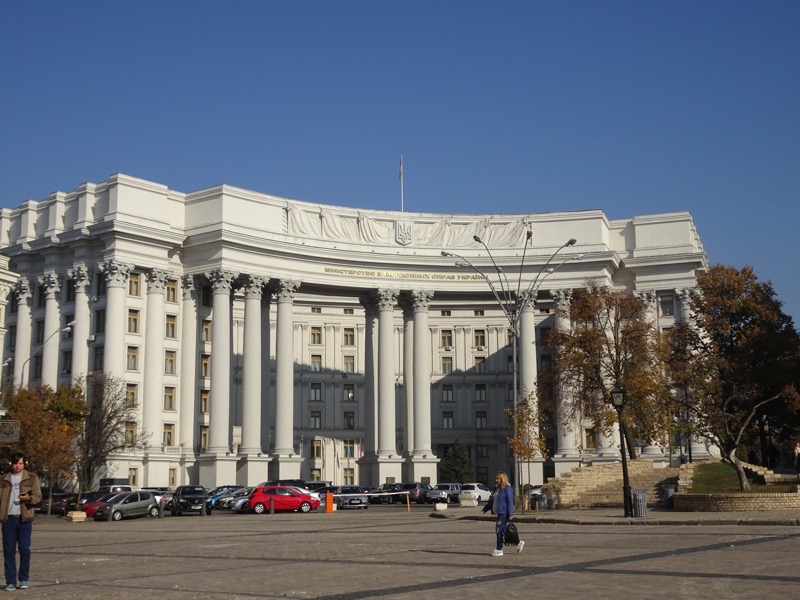
St. Michael’s Golden-Domed Monastery is located on the right bank of the Dnieper River in middle of the historic administrative/governmental, Uppertown. It overlooks the city’s historical commercial and merchant quarter known as the Podil. Originally it was built in
Originally built in the Middle Ages by Sviatopolk II Iziaslavych, who was the supreme ruler of the Kievan Rus for about 20 years (1093 to 1113), the monastery is made up of a Cathedral, the Refectory of St. John the Divine, the Economic Gates, and the monastery’s bell tower, which were all added in the 18th century. The exterior of the monastery was rebuilt in the Ukrainian Baroque style at that time while the interior is in the original Byzantine style… none of which really means anything because the original cathedral was completely demolished by Soviet authorities in the 1930s, and was then completely reconstructed and opened in 1999 following Ukrainian independence that happened in 1991! So the whole thing is new anyway.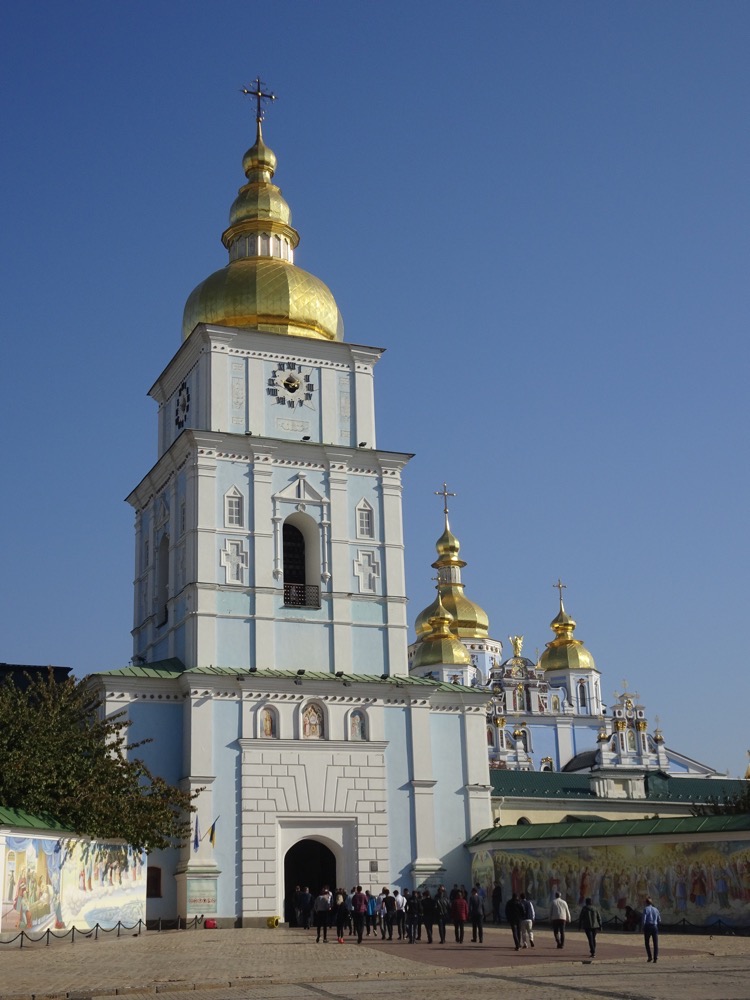
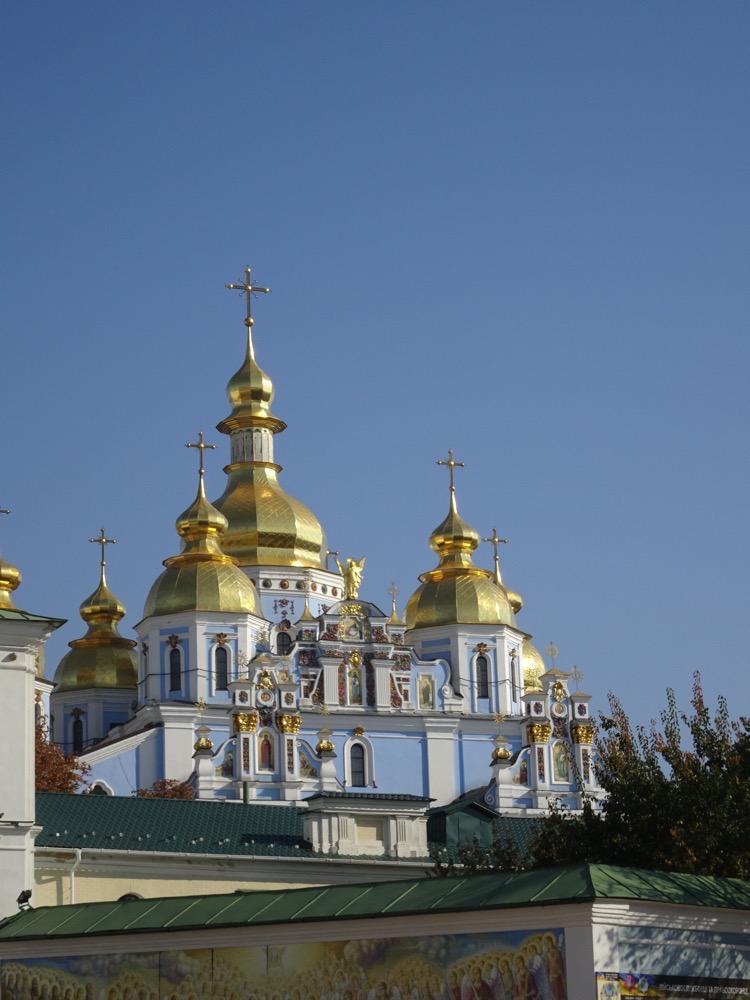
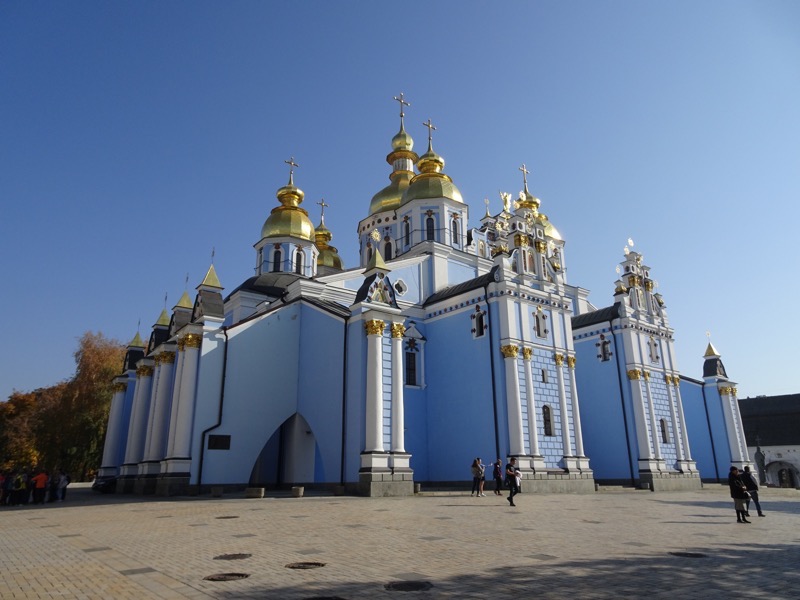
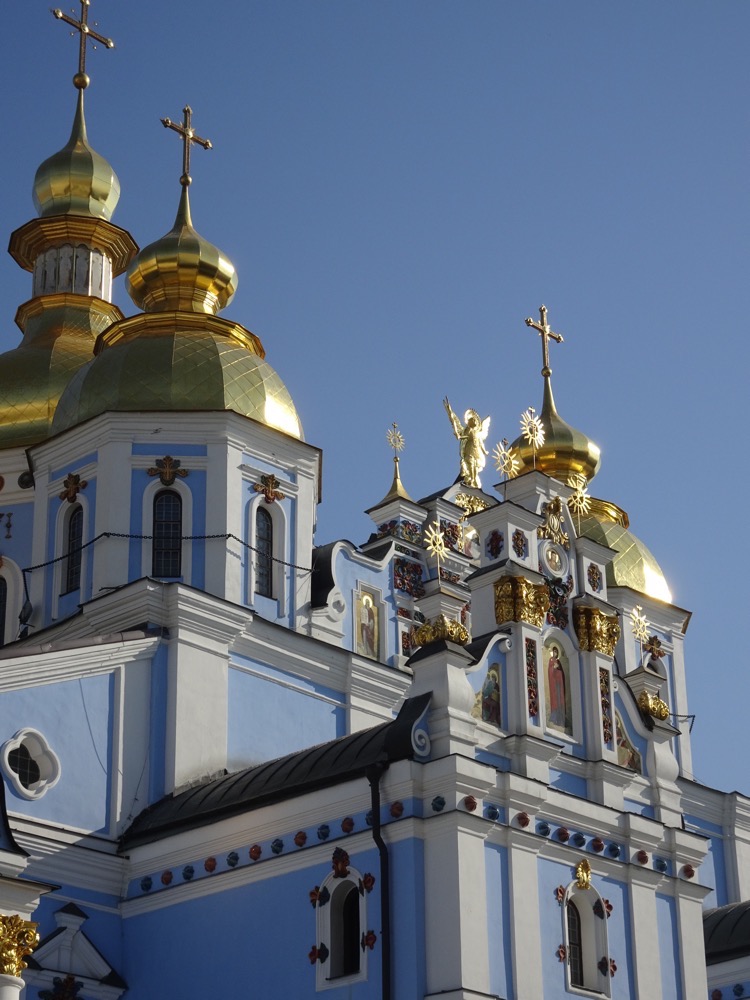
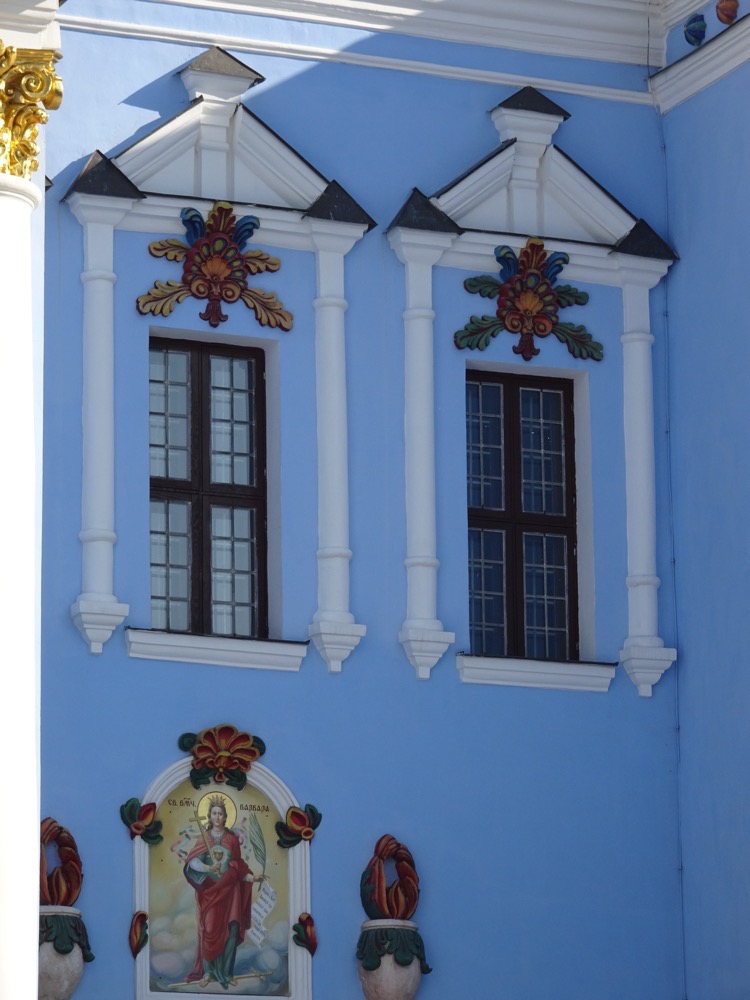 No photography is allowed inside, so I have totally stolen a picture from the Internet*:
No photography is allowed inside, so I have totally stolen a picture from the Internet*:
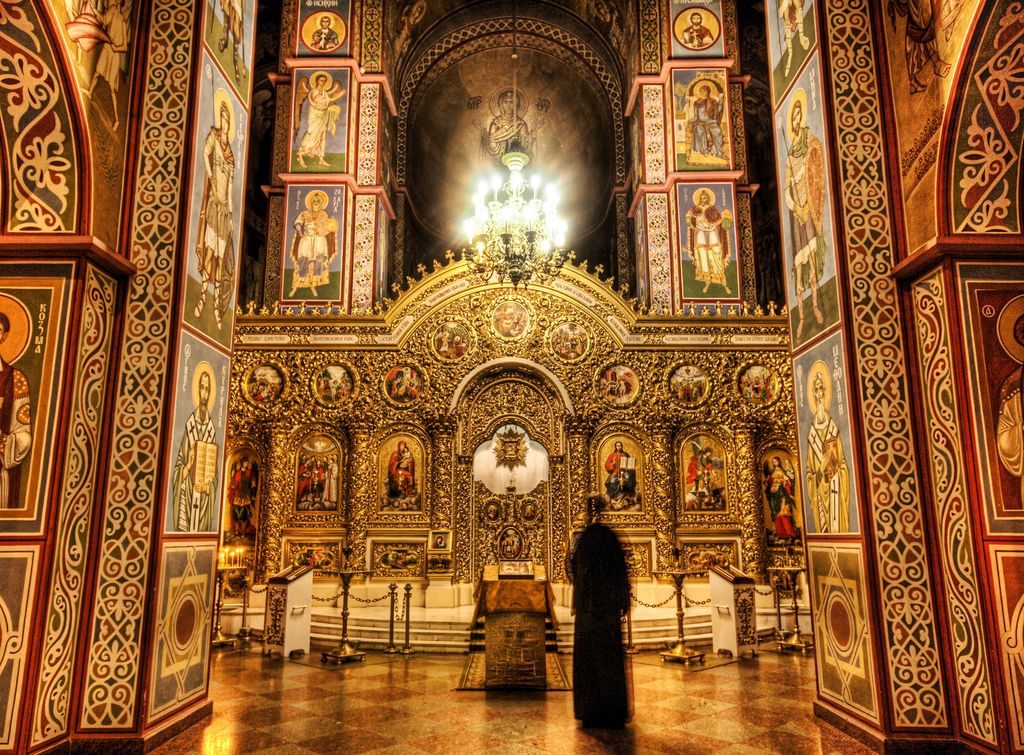 *I would normally list a photo credit, but I found this image on Pinterest, which as you all know is where all copyright and image credit information, goes to die. 🙁
*I would normally list a photo credit, but I found this image on Pinterest, which as you all know is where all copyright and image credit information, goes to die. 🙁
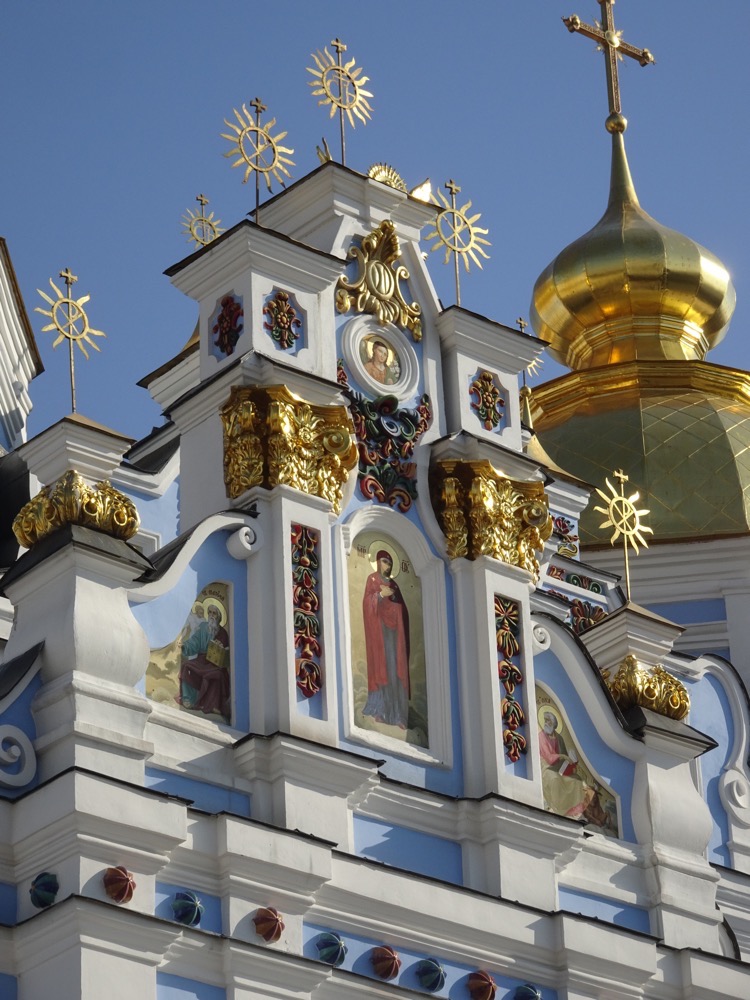
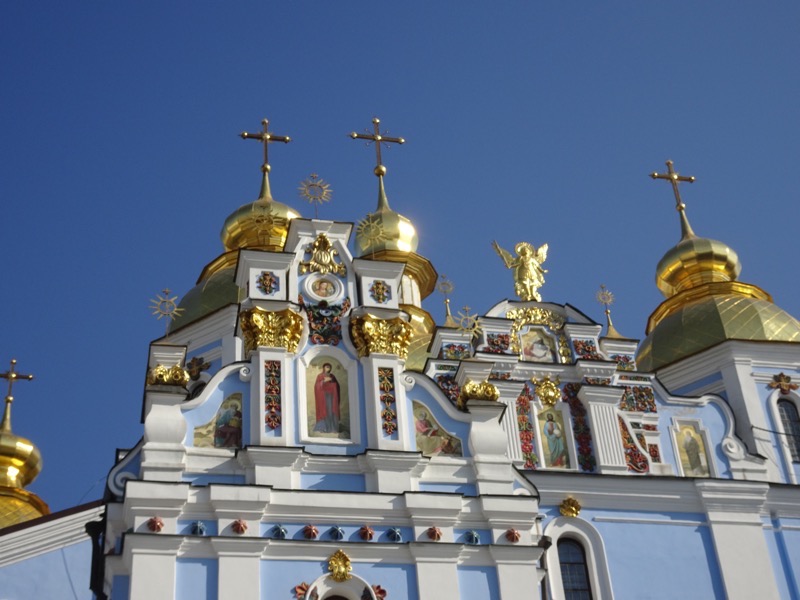
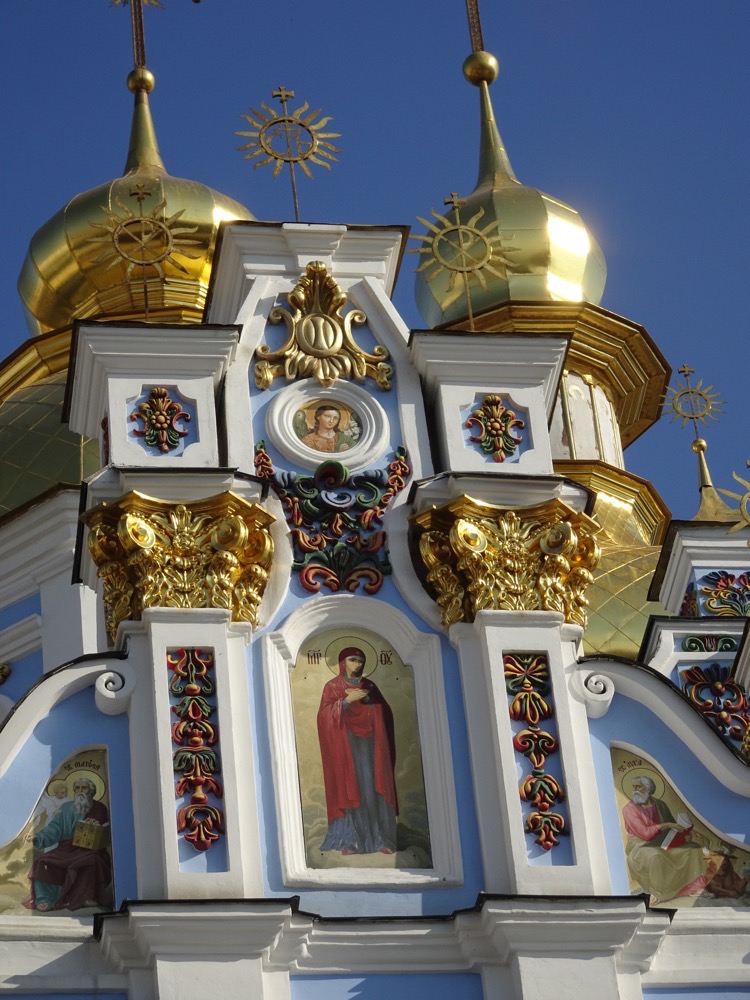 Fountain on the monastery grounds – and the first of several ‘wishing spot’ today. Wet a coin and see if you can get it to stick to the metal fountain taps, if it sticks, the wish will come true. My Australian 5c piece was just too heavy for the task (or the powers that be in the Monastery Business know I atheist/heathen type, and aren’t into granting wishes to people like me!)
Fountain on the monastery grounds – and the first of several ‘wishing spot’ today. Wet a coin and see if you can get it to stick to the metal fountain taps, if it sticks, the wish will come true. My Australian 5c piece was just too heavy for the task (or the powers that be in the Monastery Business know I atheist/heathen type, and aren’t into granting wishes to people like me!)
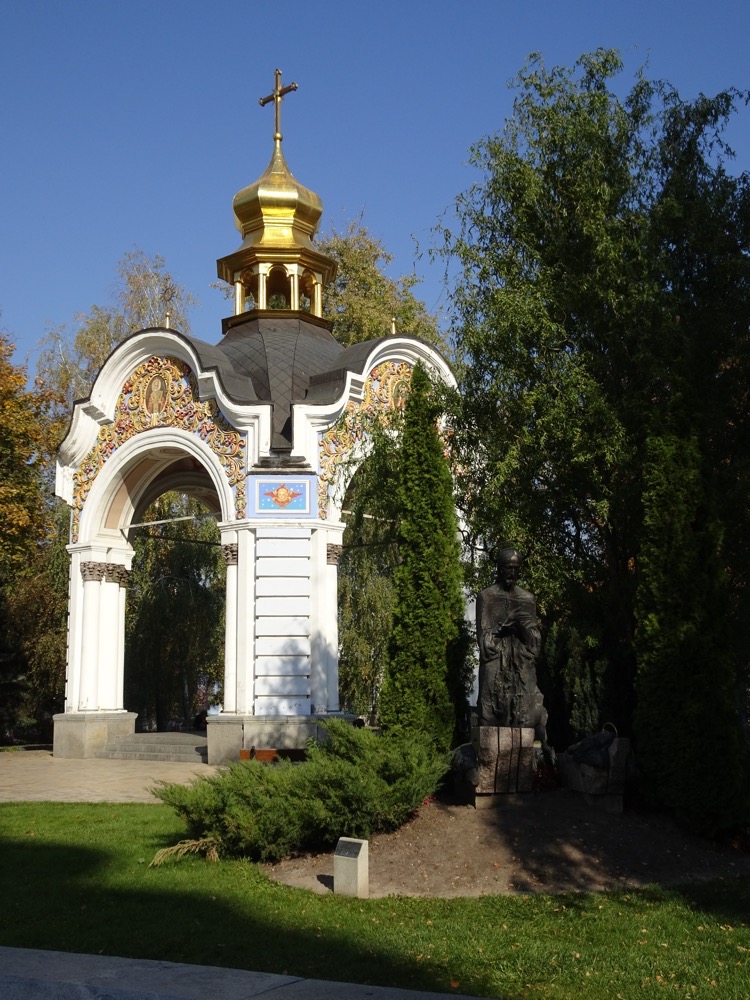
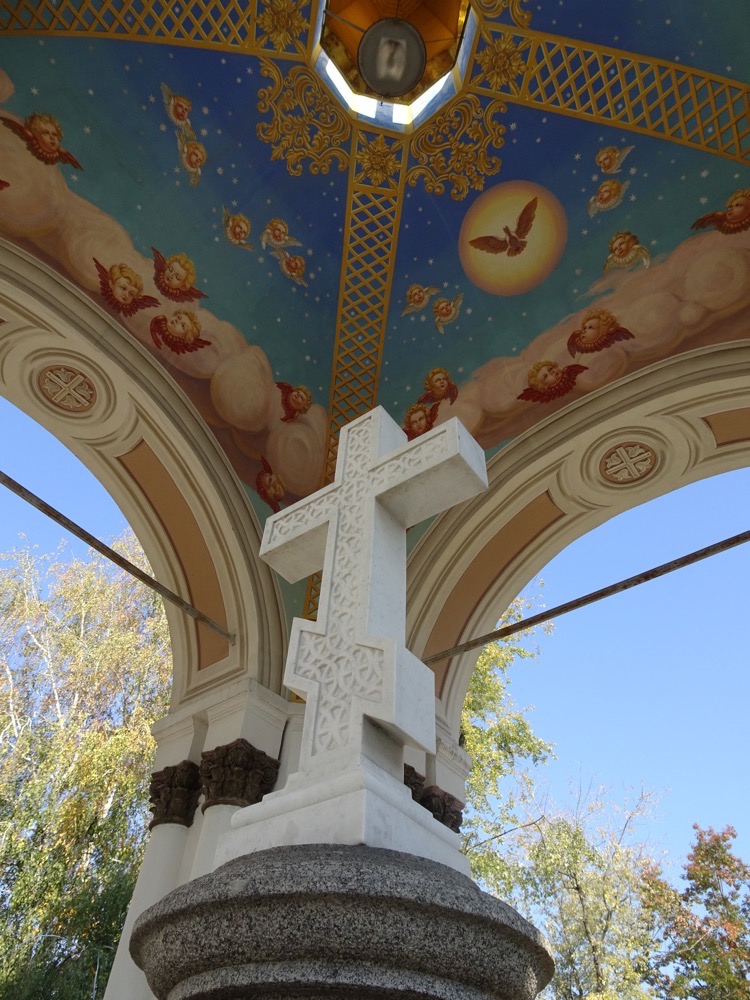
Directly outside St Michael’s Monastery is where Kiev lived through its most recent violent political upheaval. The Revolution of Dignity, as referred to as Euromaidan was a nationwide Ukrainian protest movement that lasted from November 2013 to February 2014. The historic events that took place here were precipitated from the abject rejection of the European foreign policy development vector, and the last minute refusal of the Ukranian government to sign the EU Association Agreement. The protests started peaceably enough but after ten days of peaceful protesting, the government resorted to violence and sent in Special Forces troops to Kiev’s main square Maidan Nezalezhnotsti (Independence Square) to disperse the protestors which saw many young protestors brutally beaten. The protestors took to the Monastery for shelter and the church turned into a makeshift kitchen, clothing distribution point, information and press distribution centre, and even emergency operating room. The protest turned into a longstanding civil disobedience campaign against unchecked state power, corruption and blatant human rights abuses and one hundred people died in the uprising. The ‘Heavenly Hundred’ are commemorated all over this part of the city – in particular on the street outside our hotel, the Ukraine Hotel, which was sadly used by the government as a sniper tower when dispersing the protests.
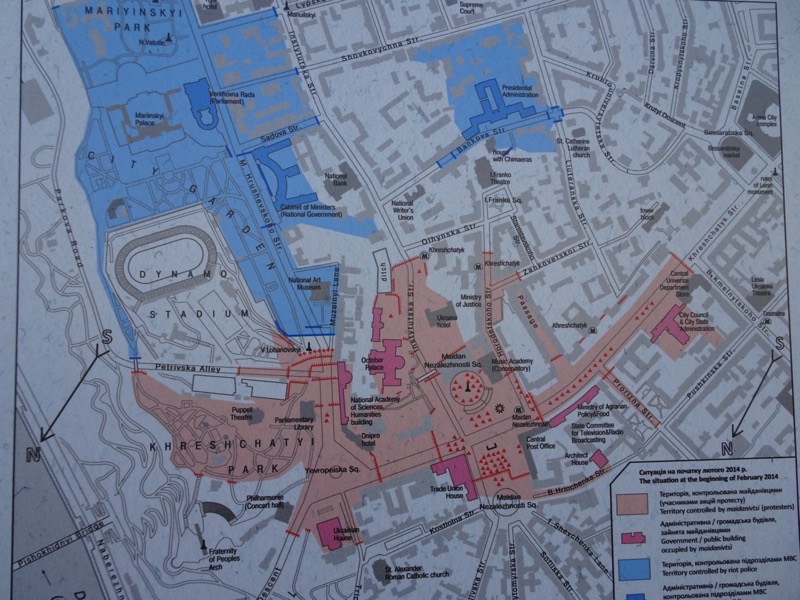 Our next point of interest was hopefully something a little less morose, St Andrew’s Church, which is a major Baroque church constructed between 1747 and 1754, It overlooks the historic Podil neighbourhood and is situation on a steep embankment called Andriyivska Hill. Currently, the church have become a major headache for local conservationists as the foundations have started to shift, causing worry that the entire building may collapse… pieces of the church’s decor have been found down the hill called St Andrew’s Descent. :/
Our next point of interest was hopefully something a little less morose, St Andrew’s Church, which is a major Baroque church constructed between 1747 and 1754, It overlooks the historic Podil neighbourhood and is situation on a steep embankment called Andriyivska Hill. Currently, the church have become a major headache for local conservationists as the foundations have started to shift, causing worry that the entire building may collapse… pieces of the church’s decor have been found down the hill called St Andrew’s Descent. :/
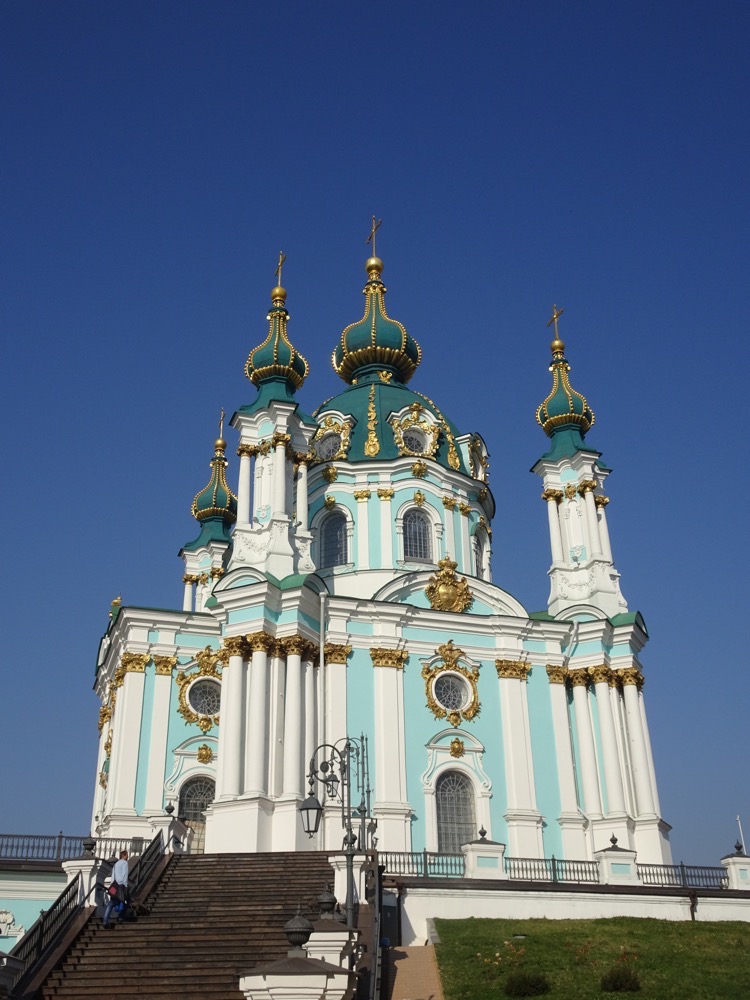
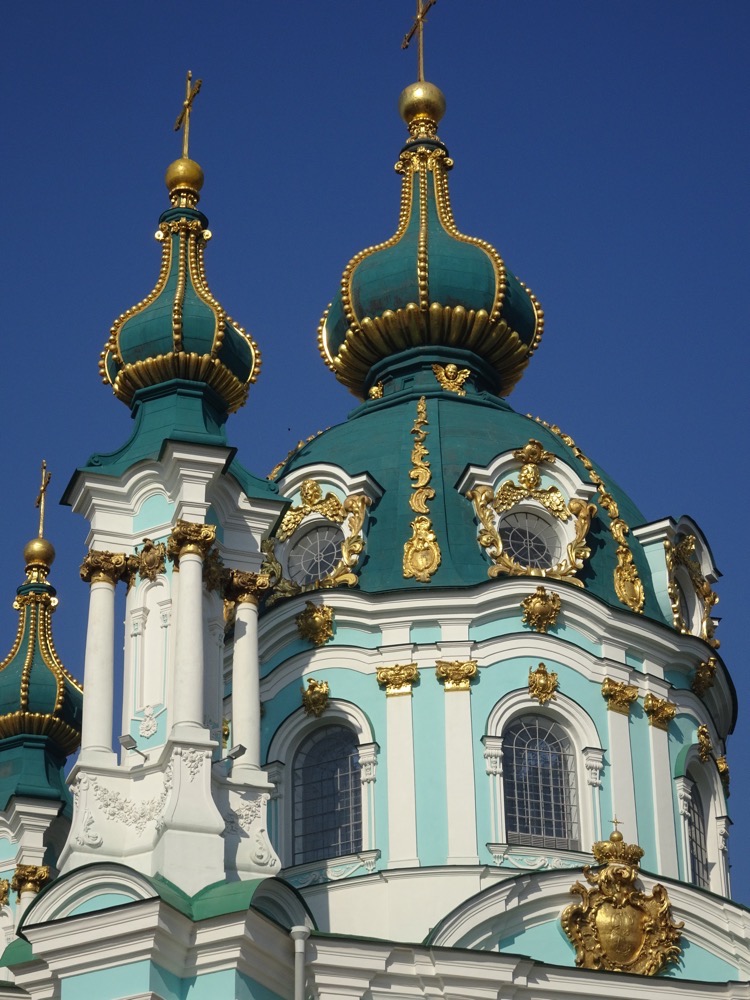 The Descent is considered ‘Kiev’s Montemarte’ and is a parade full of the work of local artists visible from the viewing platform at the base of the church.
The Descent is considered ‘Kiev’s Montemarte’ and is a parade full of the work of local artists visible from the viewing platform at the base of the church.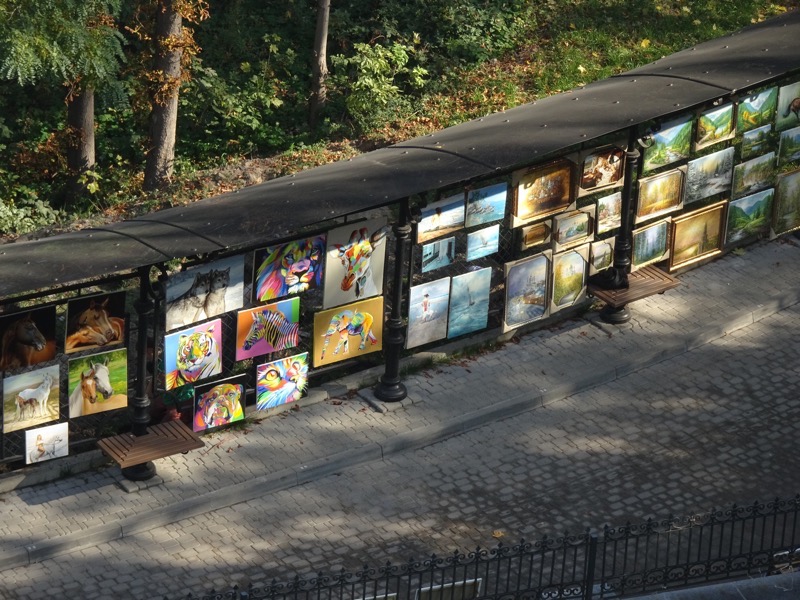 The diversity of architecture in the city is quite stunning.
The diversity of architecture in the city is quite stunning.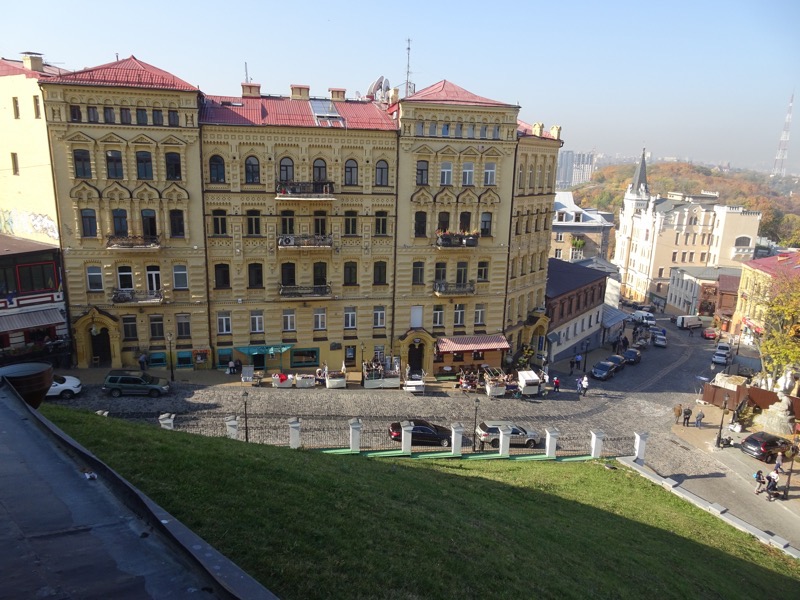
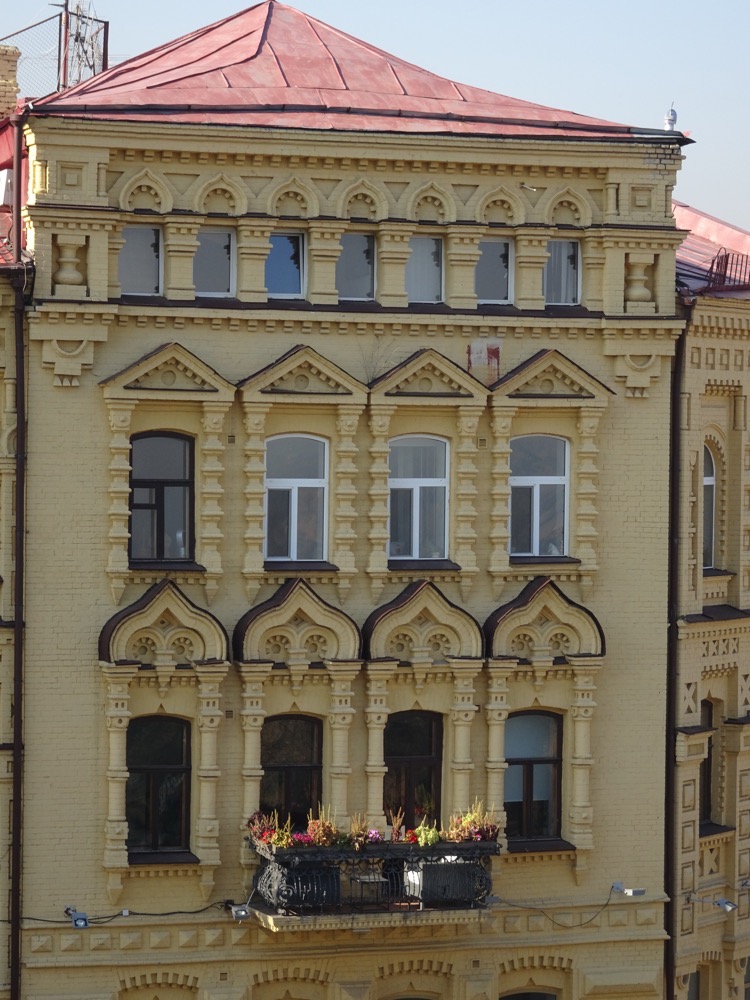
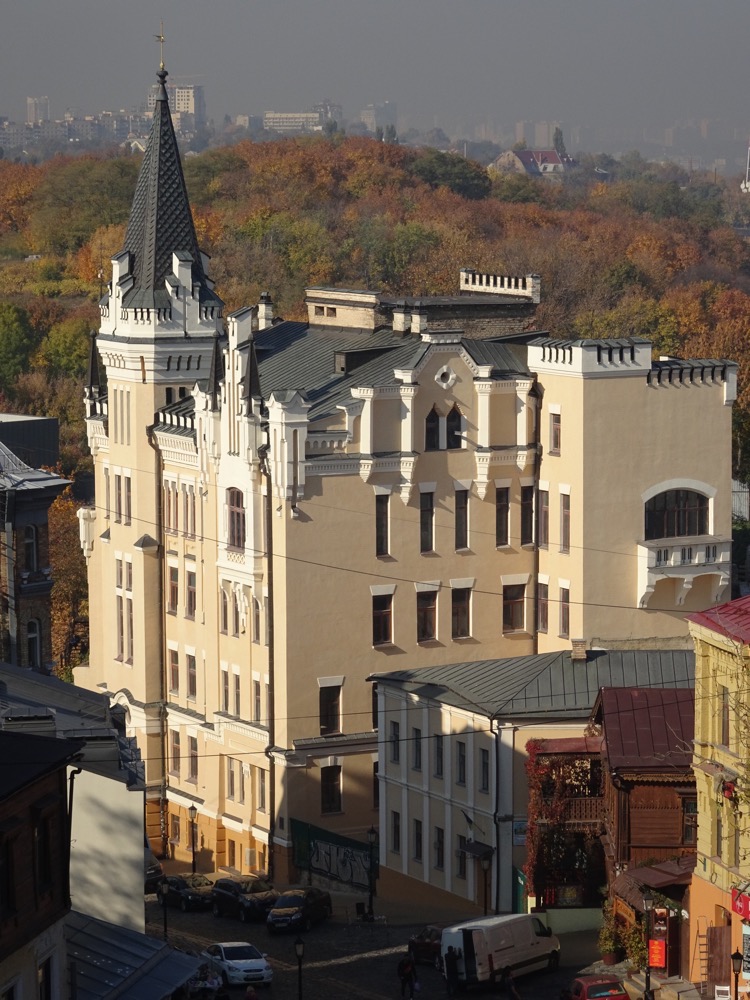
After St Andrew’s we headed to see the Theramin Fountain, which is one of seven iron fountains manufactured in the factory Alexei Theremin, in the pre-revolutionary era. Theremin had been commissioned to build several fountains for the city and was known for being an abusive and foul-mouthed boss. 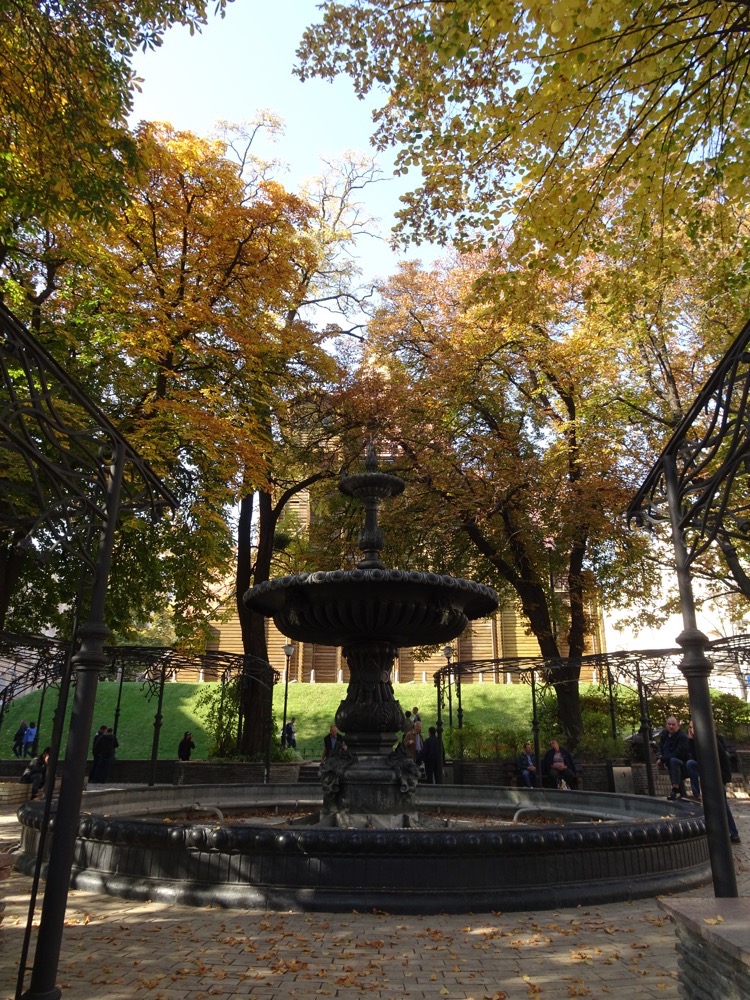
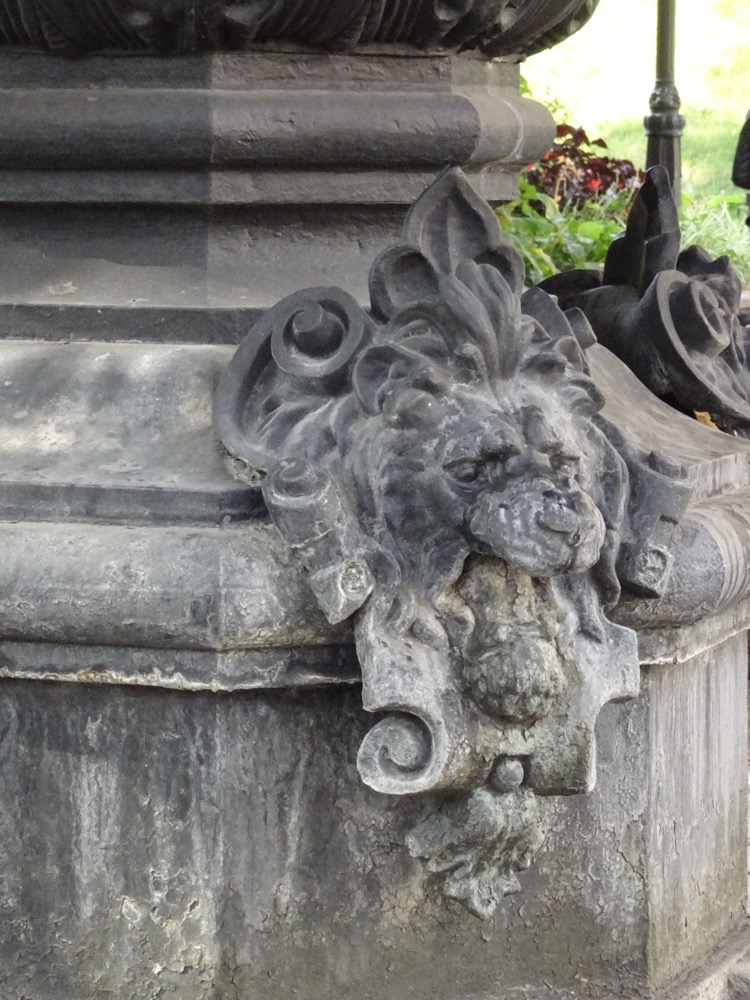 This fountain, which ended up bearing his name was the final fountain in the commission and unfortunately for Alexei, he left town a few days before it was completed and placed in situ. His workers, who were apparently all fed up with his abuse replaced several lions heads that were intended for the fountain with a representation of Alexei’s face – spewing water forth like the vitriol he spewed at his worker. When he came back and saw his likeness on the fountain, he was apparently none too impressed and attempted to buy back the fountain from the commissioning authority, but they were having none of it and so it remained.
This fountain, which ended up bearing his name was the final fountain in the commission and unfortunately for Alexei, he left town a few days before it was completed and placed in situ. His workers, who were apparently all fed up with his abuse replaced several lions heads that were intended for the fountain with a representation of Alexei’s face – spewing water forth like the vitriol he spewed at his worker. When he came back and saw his likeness on the fountain, he was apparently none too impressed and attempted to buy back the fountain from the commissioning authority, but they were having none of it and so it remained.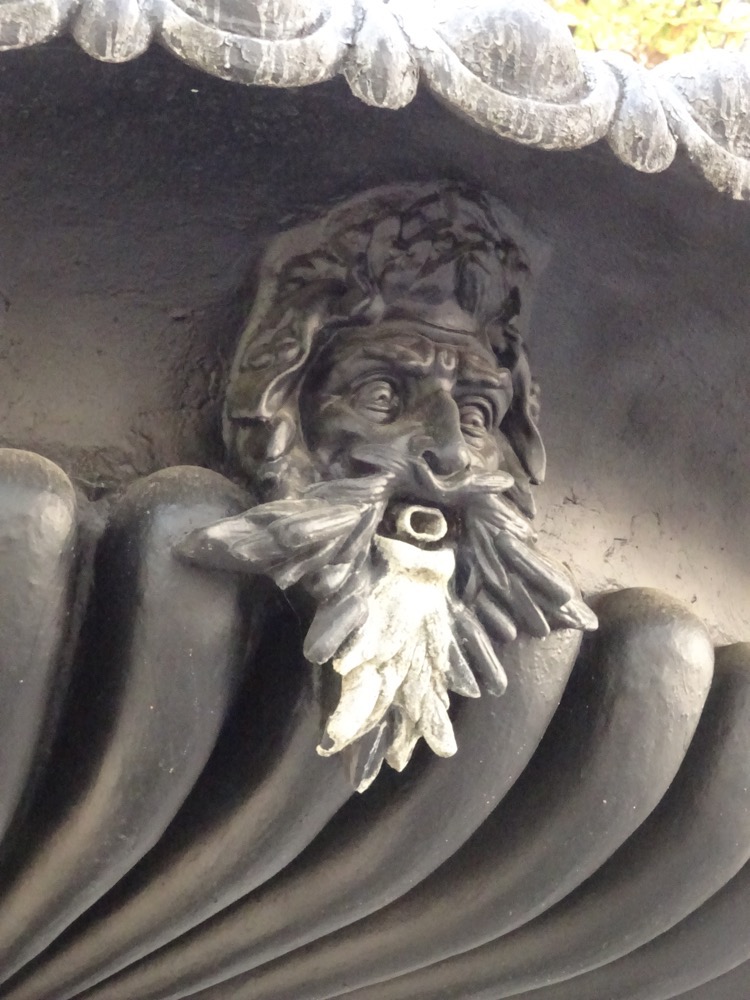 Nearby a piece of art designed to draw attention to the world’s plastic plight. There’s a cat thing in this city – not sure why…
Nearby a piece of art designed to draw attention to the world’s plastic plight. There’s a cat thing in this city – not sure why…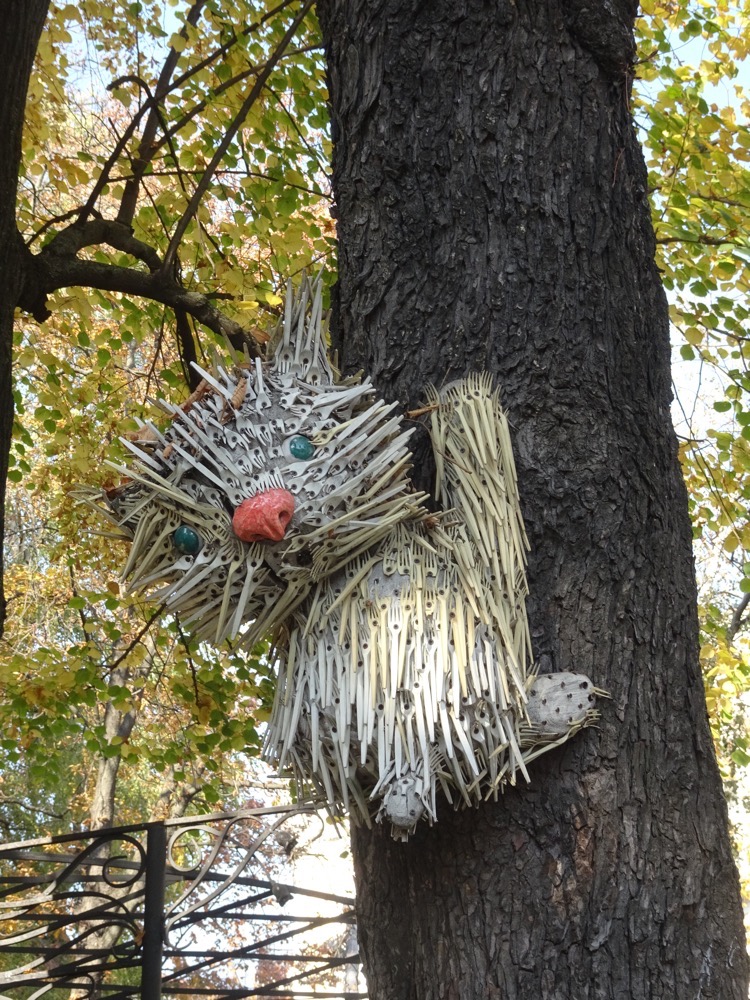 Just around the corner from the fountain is the Golden Gates of Kyiv which was where the main fortification gates of the city were located in the 11th century. It was named in imitation of the Golden Gate of Constantinople (not Istanbul!) but the structure was destroyed in the middle ages, so there were only ruins on this site and no one knew what they original gates looked like. In 1982, the Soviet government decided they should be rebuilt and this is what was created even though many different reconstructions were proposed?! So the original medieval gates probably looked nothing like this at all…
Just around the corner from the fountain is the Golden Gates of Kyiv which was where the main fortification gates of the city were located in the 11th century. It was named in imitation of the Golden Gate of Constantinople (not Istanbul!) but the structure was destroyed in the middle ages, so there were only ruins on this site and no one knew what they original gates looked like. In 1982, the Soviet government decided they should be rebuilt and this is what was created even though many different reconstructions were proposed?! So the original medieval gates probably looked nothing like this at all…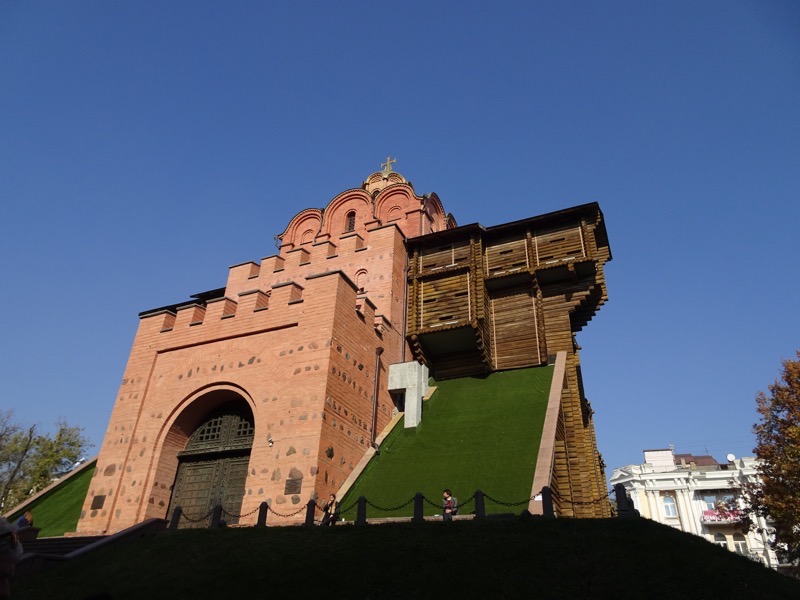
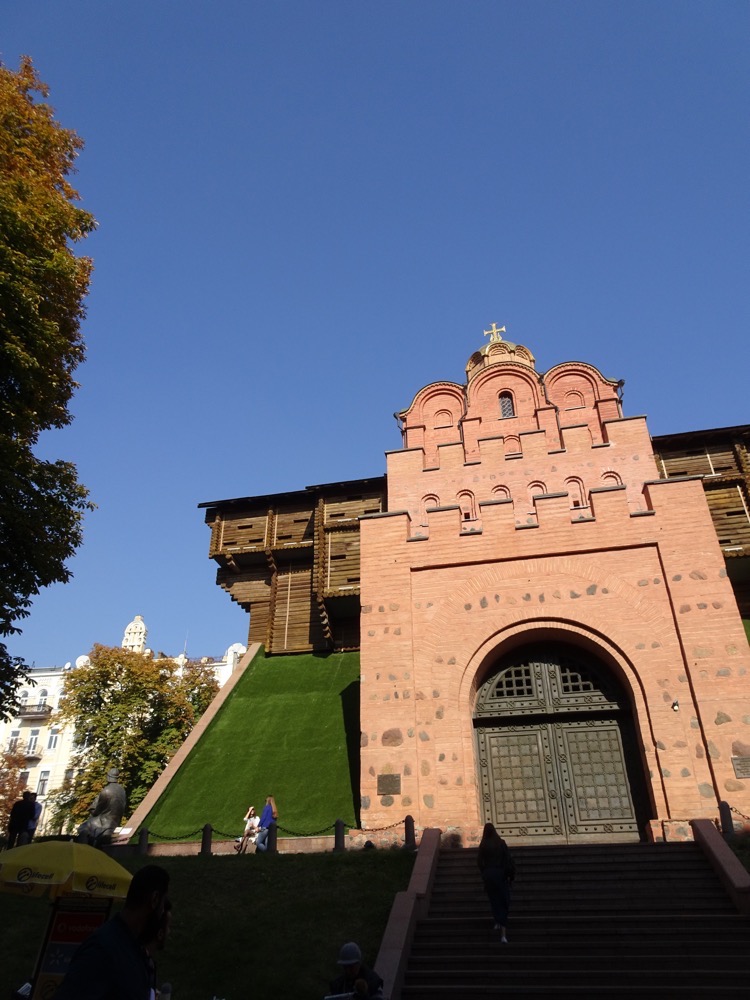
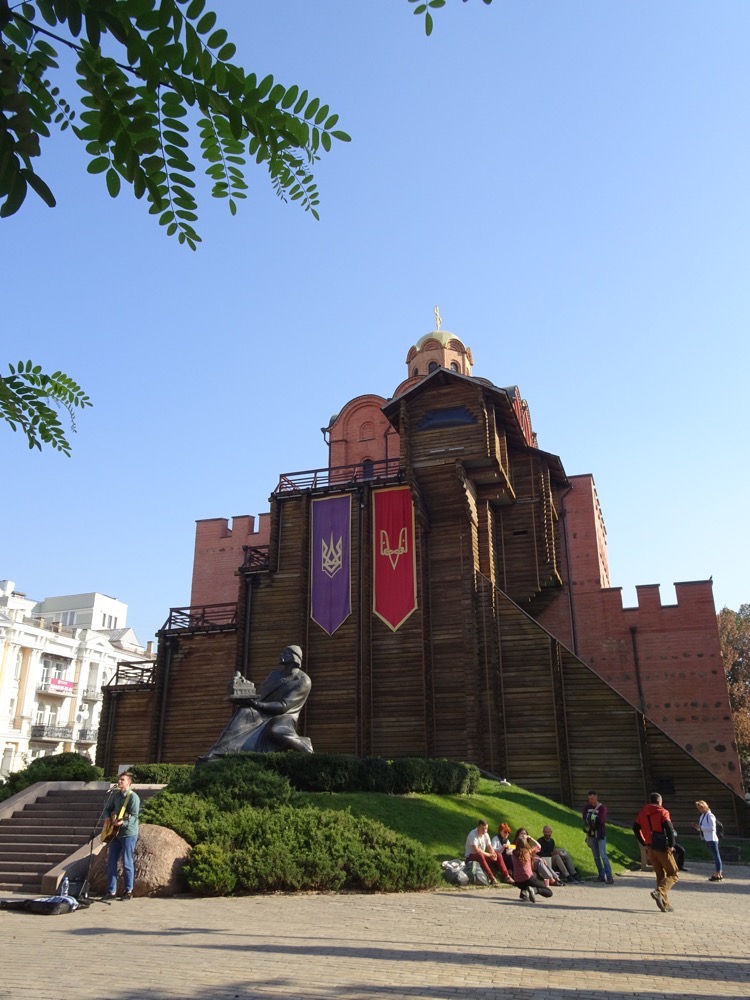
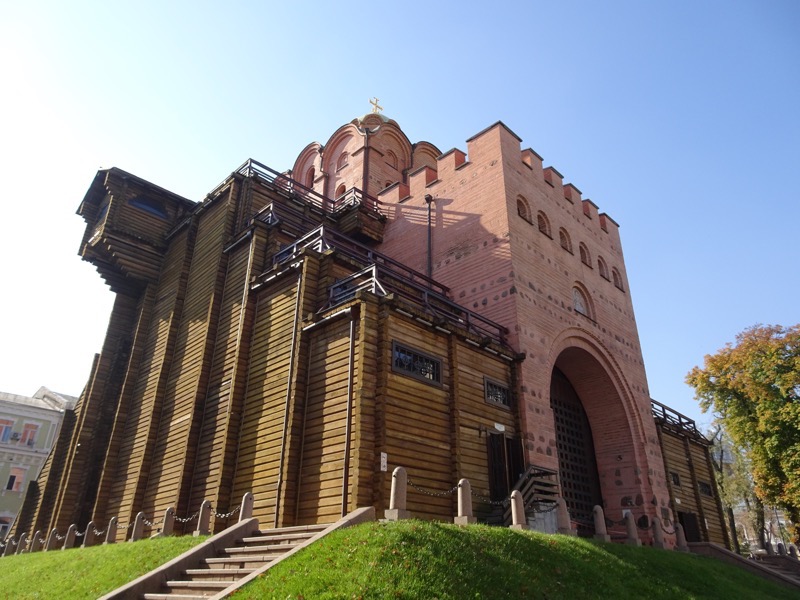 Nearby is a statue of a cat named Pantyusha who lived in the kitchen of a local restaurant. He was a well-mannered one and was loved by the cooks, waiters and diners alike. At some point, poor Pantyusha died in a kitchen fire, and not long after that some of the restaurant’s regular patrons donated a statue to a nearby park. People visiting the statue stroke Pantyusha’s head and tail and whisper wishes into his ears.
Nearby is a statue of a cat named Pantyusha who lived in the kitchen of a local restaurant. He was a well-mannered one and was loved by the cooks, waiters and diners alike. At some point, poor Pantyusha died in a kitchen fire, and not long after that some of the restaurant’s regular patrons donated a statue to a nearby park. People visiting the statue stroke Pantyusha’s head and tail and whisper wishes into his ears.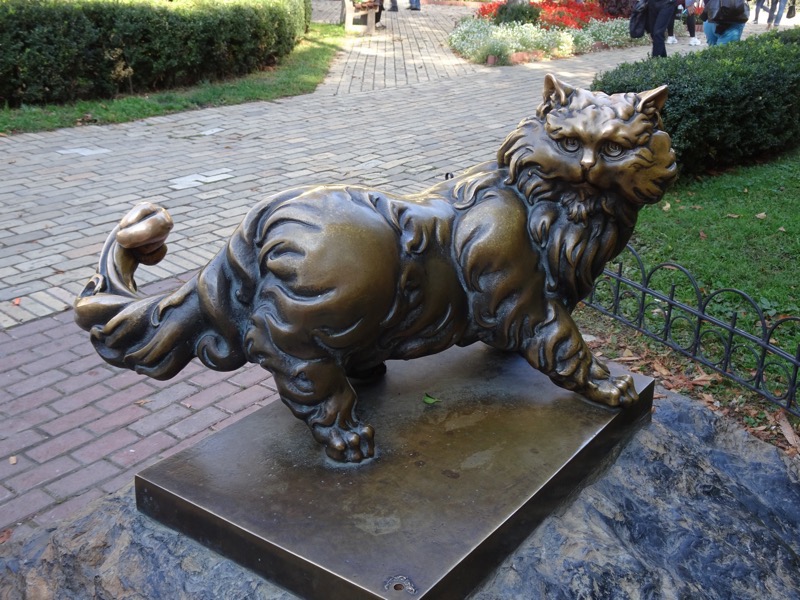 Across the street from the Golden Gate is this marvellously elaborate building that was called the Renaissance Kiev Hotel, built by a millionaire who went bust and had made the exteriors of the building so elaborate that he didn’t have money to fit it out properly. It was eventually bought by someone else who finished it and it became a popular dining place during the Soviet era, where buying a table (bribing the maitre d’hotel to give you someone else’s table) would cost you as much as your entire meal. More recently, it is seeing its own history repeating itself as it was purchased by a new owner was were going to restore the hotel to its former glory, but apparently hasn’t had the funds to complete the plan, so it’s been boarded up for about five years now.
Across the street from the Golden Gate is this marvellously elaborate building that was called the Renaissance Kiev Hotel, built by a millionaire who went bust and had made the exteriors of the building so elaborate that he didn’t have money to fit it out properly. It was eventually bought by someone else who finished it and it became a popular dining place during the Soviet era, where buying a table (bribing the maitre d’hotel to give you someone else’s table) would cost you as much as your entire meal. More recently, it is seeing its own history repeating itself as it was purchased by a new owner was were going to restore the hotel to its former glory, but apparently hasn’t had the funds to complete the plan, so it’s been boarded up for about five years now.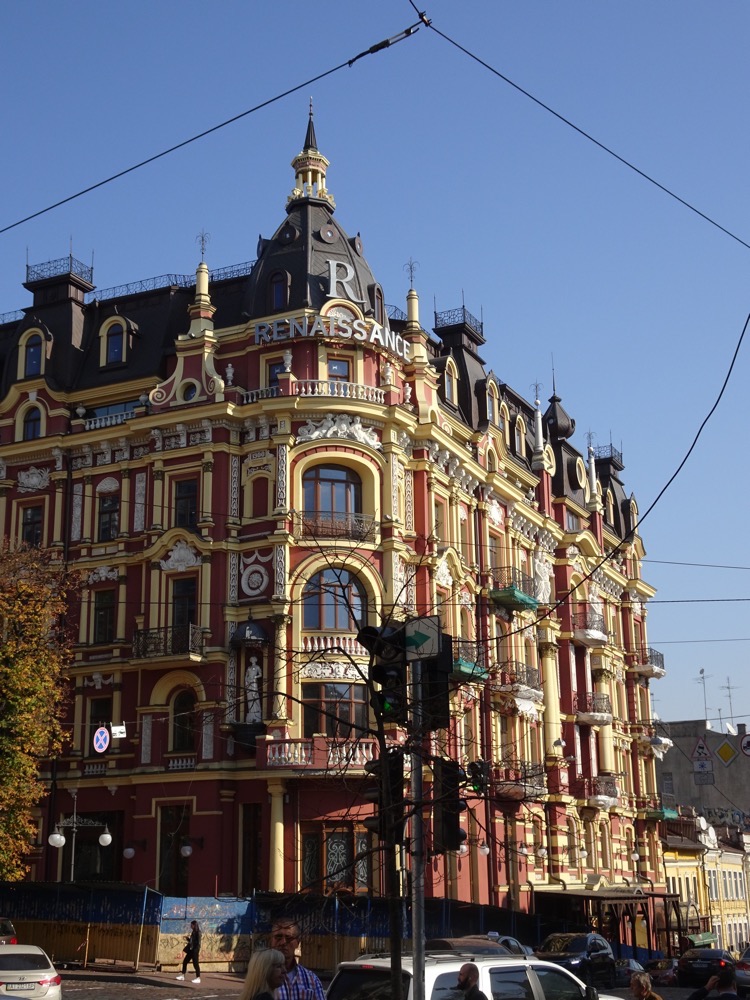 After wandering around the Golden Gate area, we made our way to the Kiev metro so we could jump a train to get to the Kiev Pechersk Lavra Monastery via the ‘deepest Metro Station in the World’– Arsenalna station which is 105.5 meters deep. First thing I noticed is how fast the escalators are moving in these stations – if you weren’t paying attention, I could imagine plenty it’d be pretty easy to be put your arse by them.
After wandering around the Golden Gate area, we made our way to the Kiev metro so we could jump a train to get to the Kiev Pechersk Lavra Monastery via the ‘deepest Metro Station in the World’– Arsenalna station which is 105.5 meters deep. First thing I noticed is how fast the escalators are moving in these stations – if you weren’t paying attention, I could imagine plenty it’d be pretty easy to be put your arse by them. 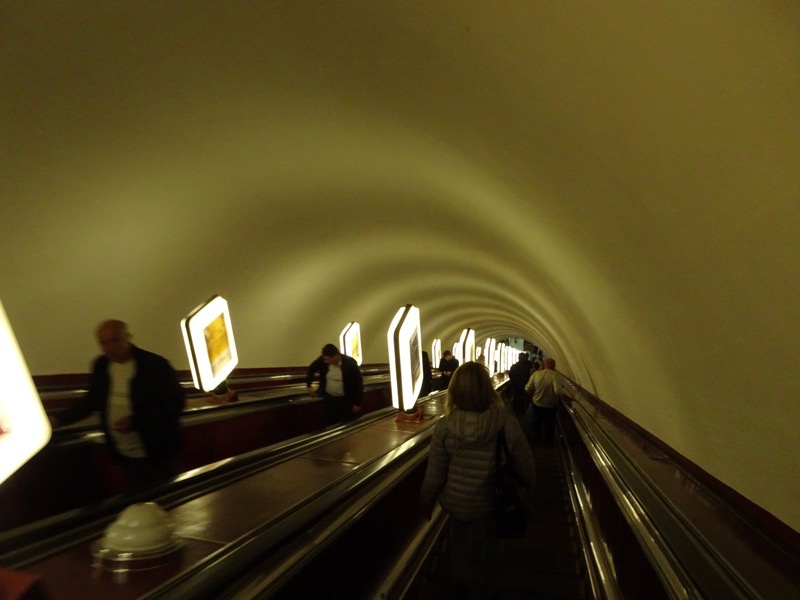 The decor is a little austere – very much in the Soviet-style not at all like the elaborate Art Nouveau and Art Deco metros in Moscow and St Petersburg, where some of the metro stations are also pretty deep – but this one takes the cake. It took a full three and a half minutes standing on the escalator to get to the surface at our destination, even with the fastest escalators I have ever seen.
The decor is a little austere – very much in the Soviet-style not at all like the elaborate Art Nouveau and Art Deco metros in Moscow and St Petersburg, where some of the metro stations are also pretty deep – but this one takes the cake. It took a full three and a half minutes standing on the escalator to get to the surface at our destination, even with the fastest escalators I have ever seen.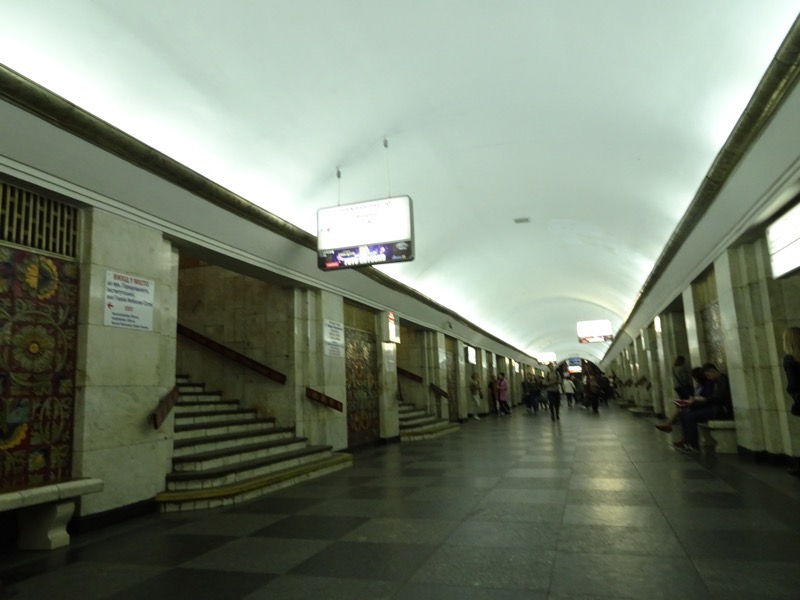
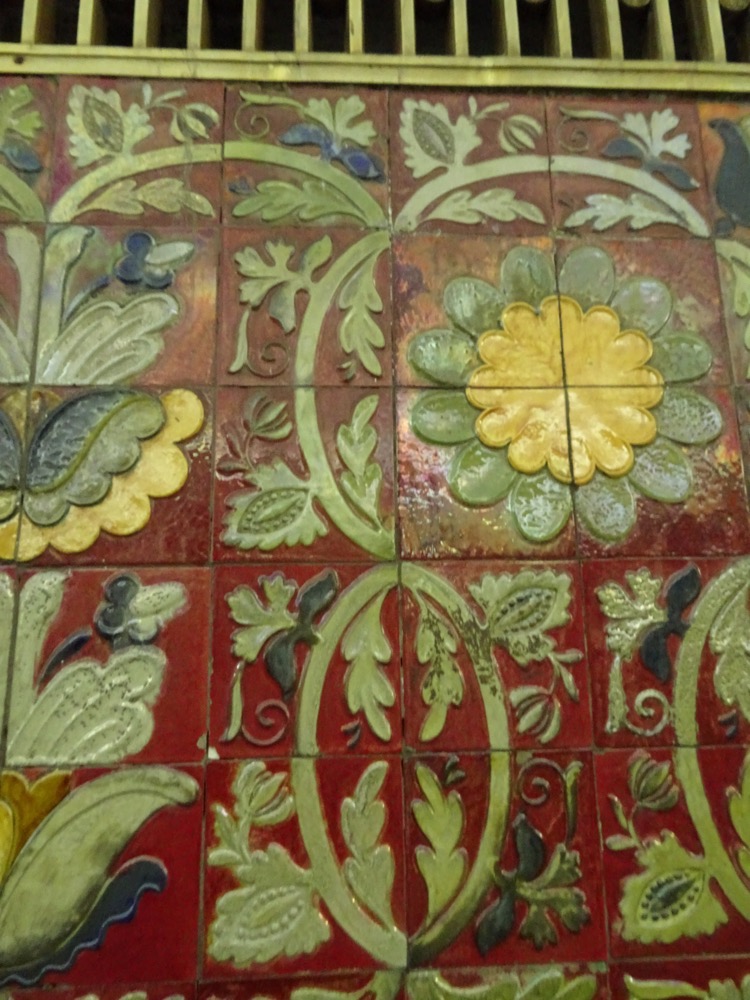
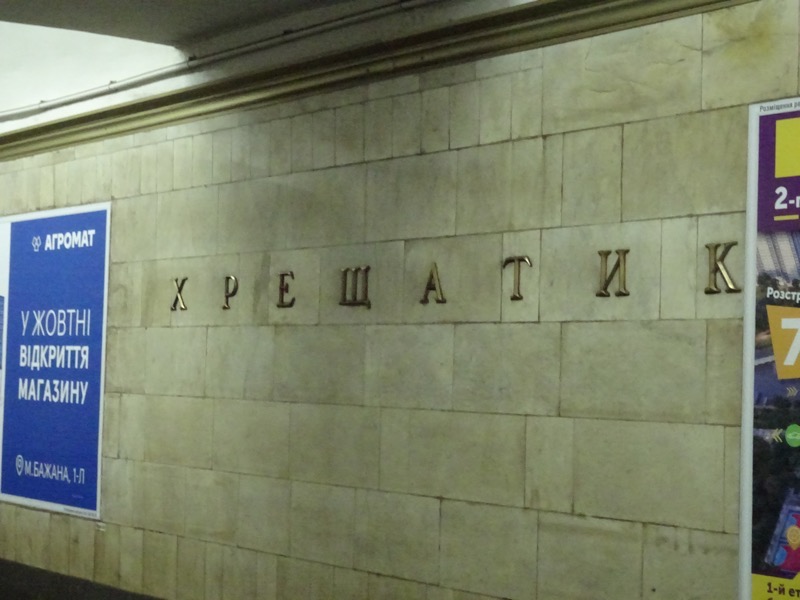
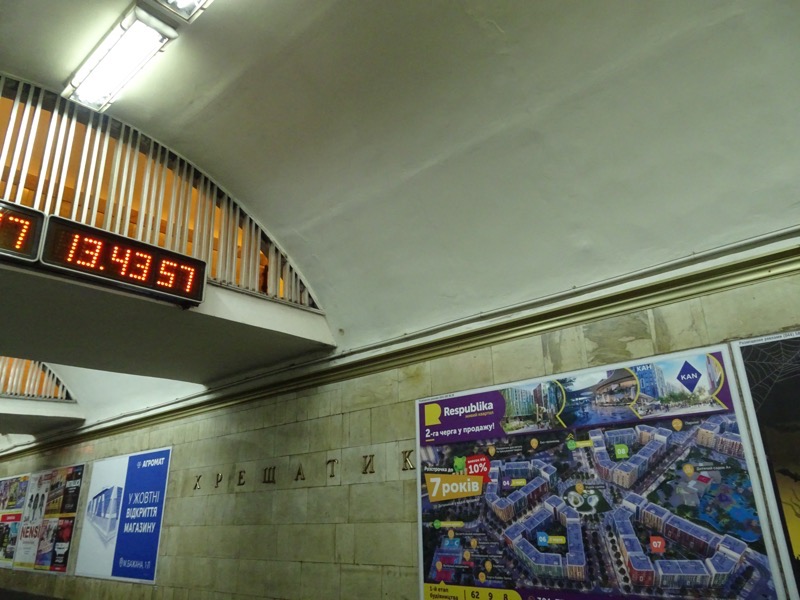
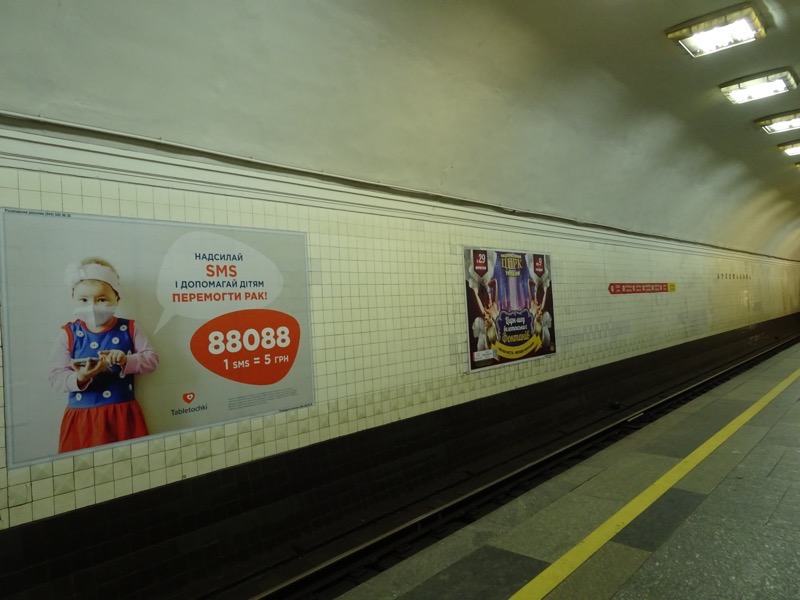
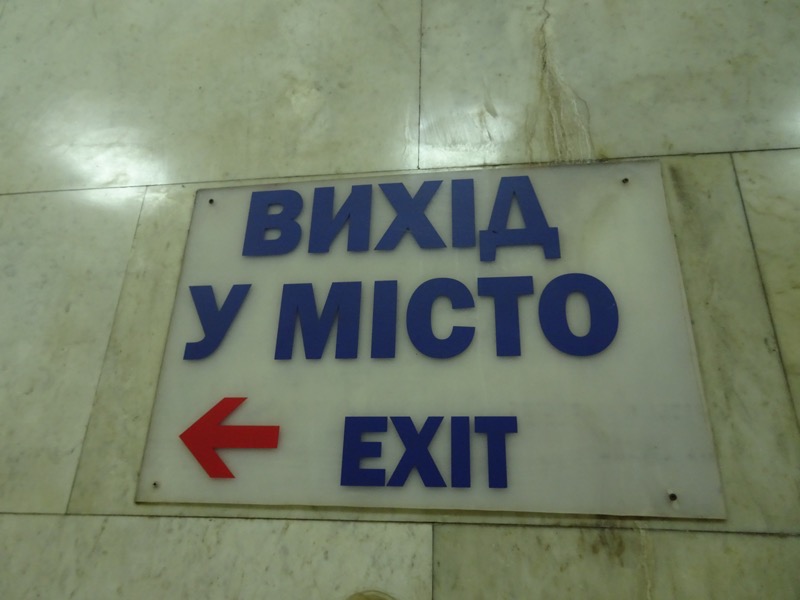 At the other end of the Metro, we took a walk along the banks of the Dnieper River towards the Lavra and got a closer look at some of the landmarks we had already briefly past.
At the other end of the Metro, we took a walk along the banks of the Dnieper River towards the Lavra and got a closer look at some of the landmarks we had already briefly past. 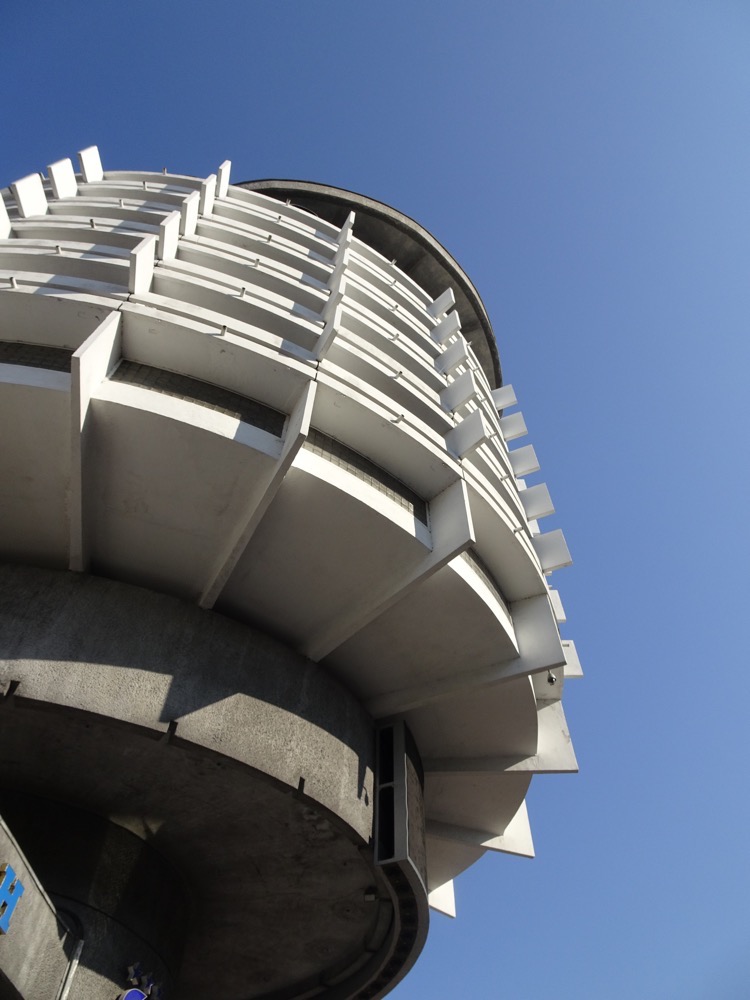 I loved this statue… it rotated which allowed you to turn it however you wanted, which meant the light was always going to be able to be on the best side for a photo.
I loved this statue… it rotated which allowed you to turn it however you wanted, which meant the light was always going to be able to be on the best side for a photo.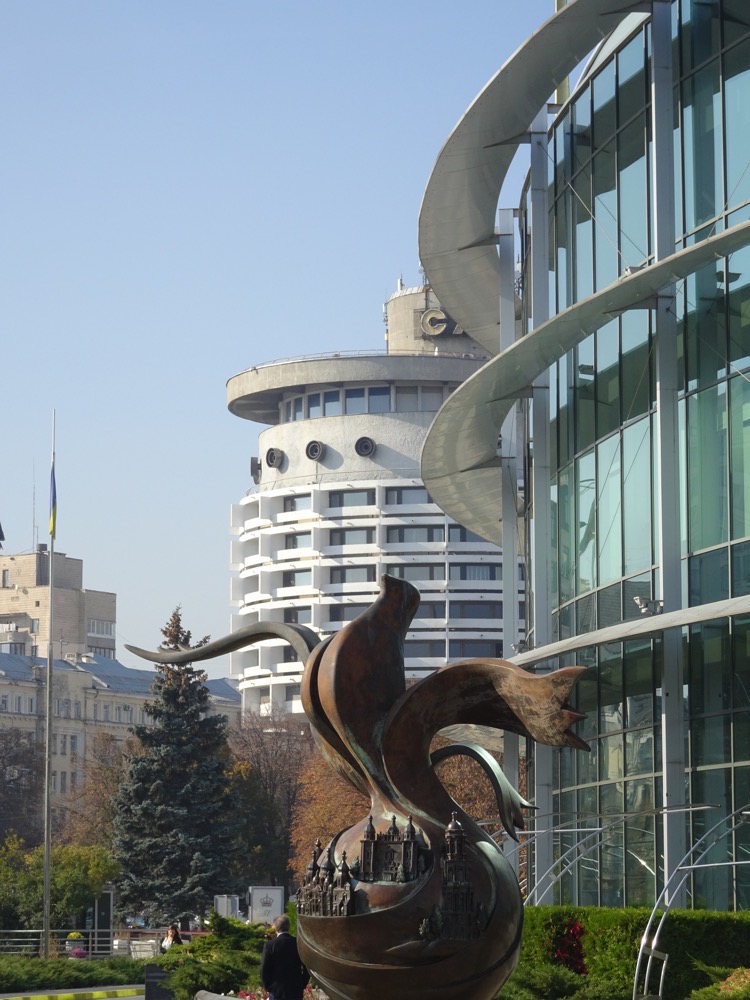 On it are represented many of the famous cathedrals, churches and monasteries of Kiev.
On it are represented many of the famous cathedrals, churches and monasteries of Kiev.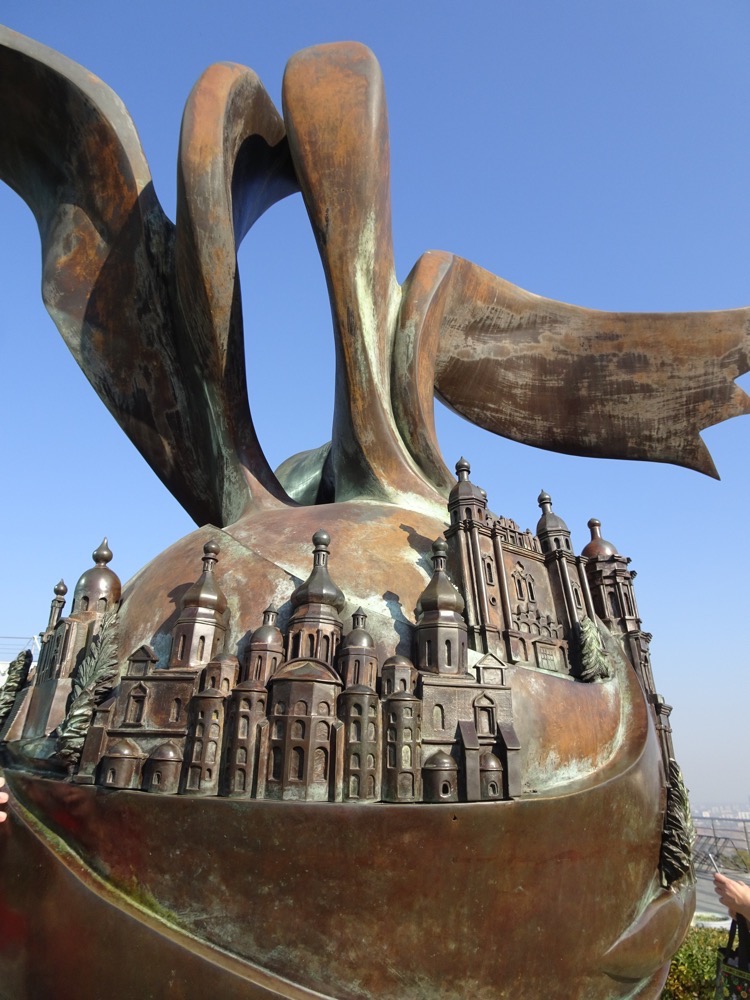
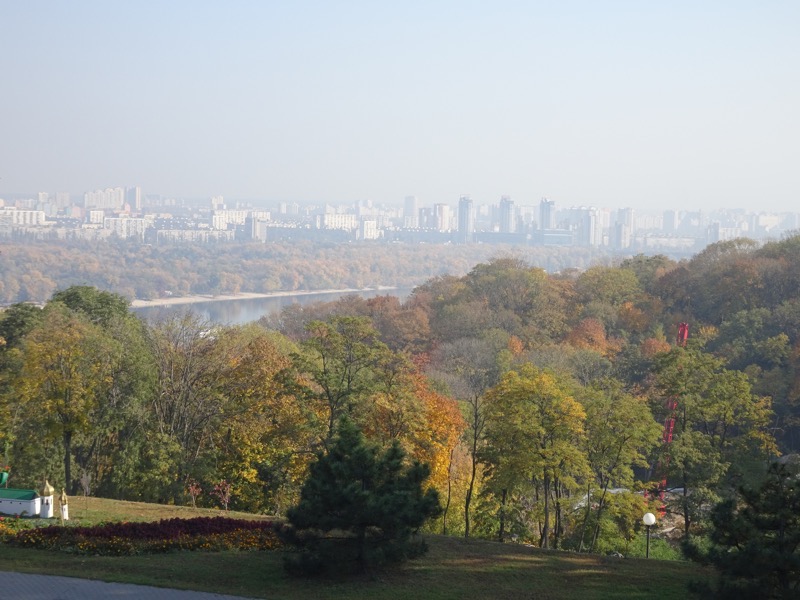 ‘The city is a little foggy and misty’, said our guide whose name I can’t pronounce and definitely couldn’t spell… foggy? poluted? potayto? potarto? It looked like this at 10am and was still ‘foggy and misty’ at 4pm.
‘The city is a little foggy and misty’, said our guide whose name I can’t pronounce and definitely couldn’t spell… foggy? poluted? potayto? potarto? It looked like this at 10am and was still ‘foggy and misty’ at 4pm.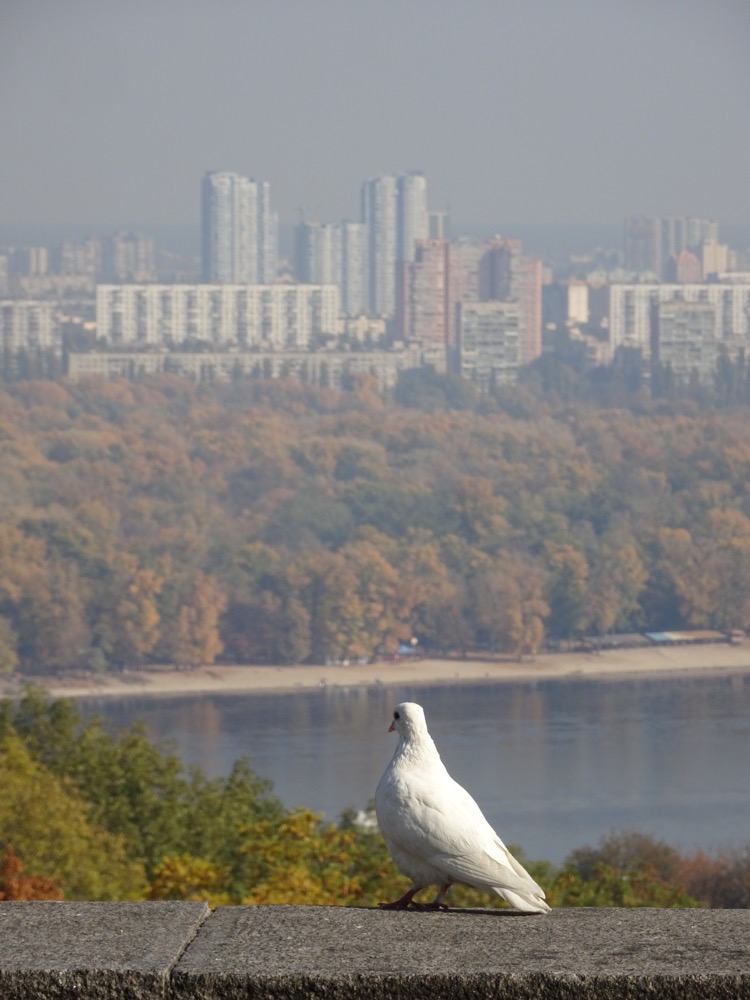
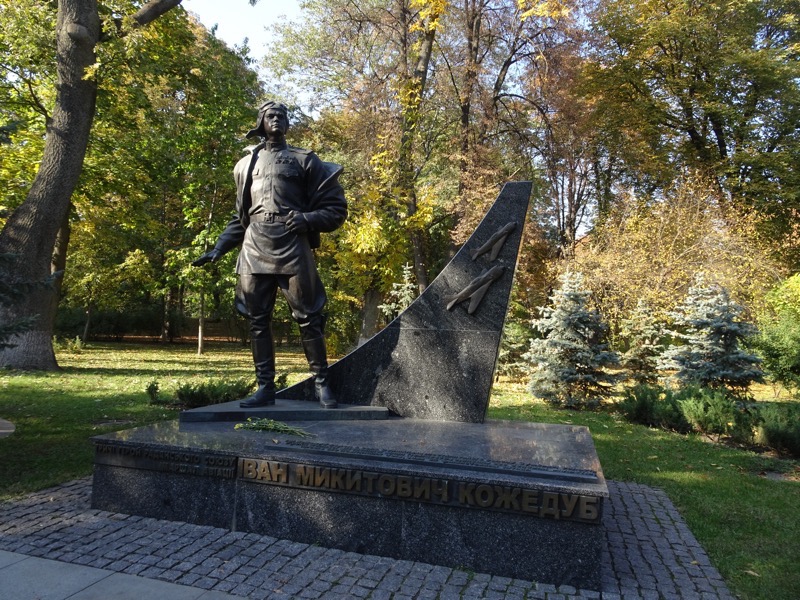 The Gate Church of the Trinity is a historic church of the ancient cave monastery of Pechersk Lavra and was originally being built in the Kievan Rus style, but is now decorated in a Ukrainian Baroque style, because like everything else in this city it appears to have been destroyed and reconstructed many times.
The Gate Church of the Trinity is a historic church of the ancient cave monastery of Pechersk Lavra and was originally being built in the Kievan Rus style, but is now decorated in a Ukrainian Baroque style, because like everything else in this city it appears to have been destroyed and reconstructed many times.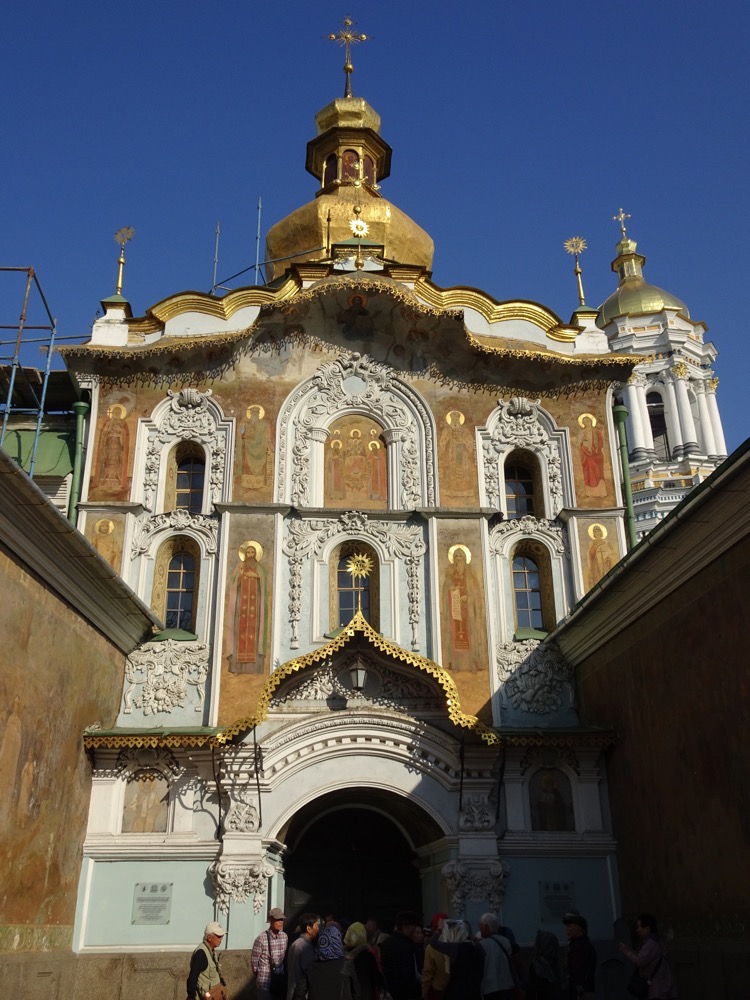 The massive Pechersk Lavra monastery complex covers nearly 30 hectares on the hillsides of Kiev overlooking the Dnieper River. Since its foundation as the cave monastery in 1051, the Lavra has been a the centre of Eastern Orthodox Christianity in Eastern Europe (so, kinda like the Eastern Orthodox, Mecca) and attracts many pilgrims each year who come to pray at the relics of saints that are preserved in the caves. It is also a UNESCO World Heritage Site, and built on a massive hillside, so a bugger of a walk to get down to the caves and back up again.
The massive Pechersk Lavra monastery complex covers nearly 30 hectares on the hillsides of Kiev overlooking the Dnieper River. Since its foundation as the cave monastery in 1051, the Lavra has been a the centre of Eastern Orthodox Christianity in Eastern Europe (so, kinda like the Eastern Orthodox, Mecca) and attracts many pilgrims each year who come to pray at the relics of saints that are preserved in the caves. It is also a UNESCO World Heritage Site, and built on a massive hillside, so a bugger of a walk to get down to the caves and back up again.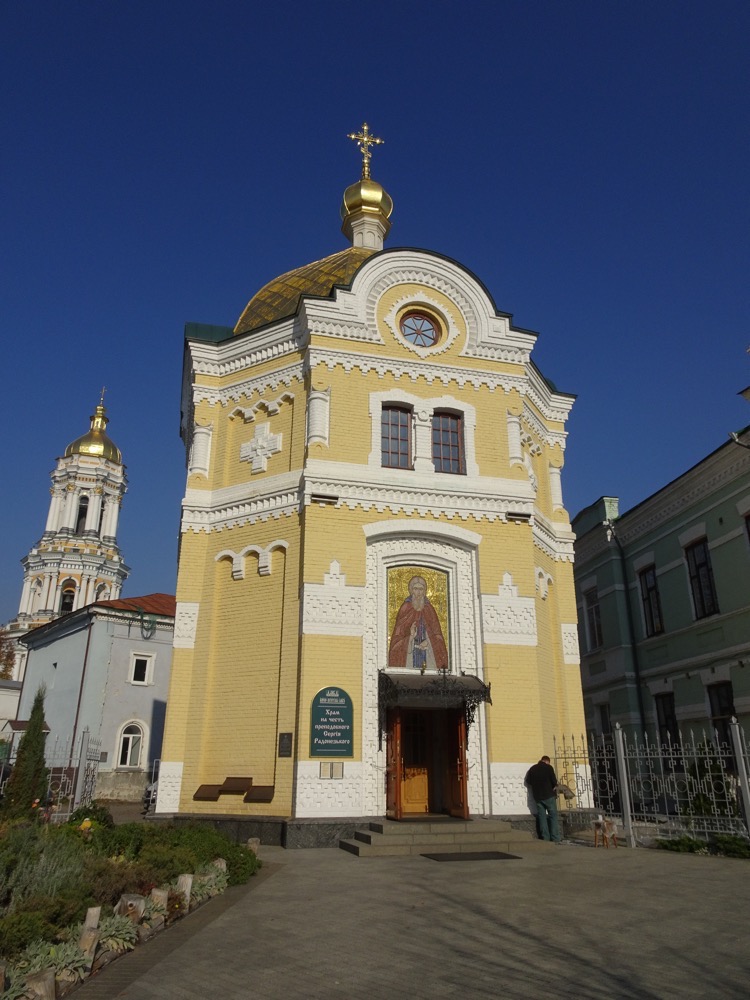
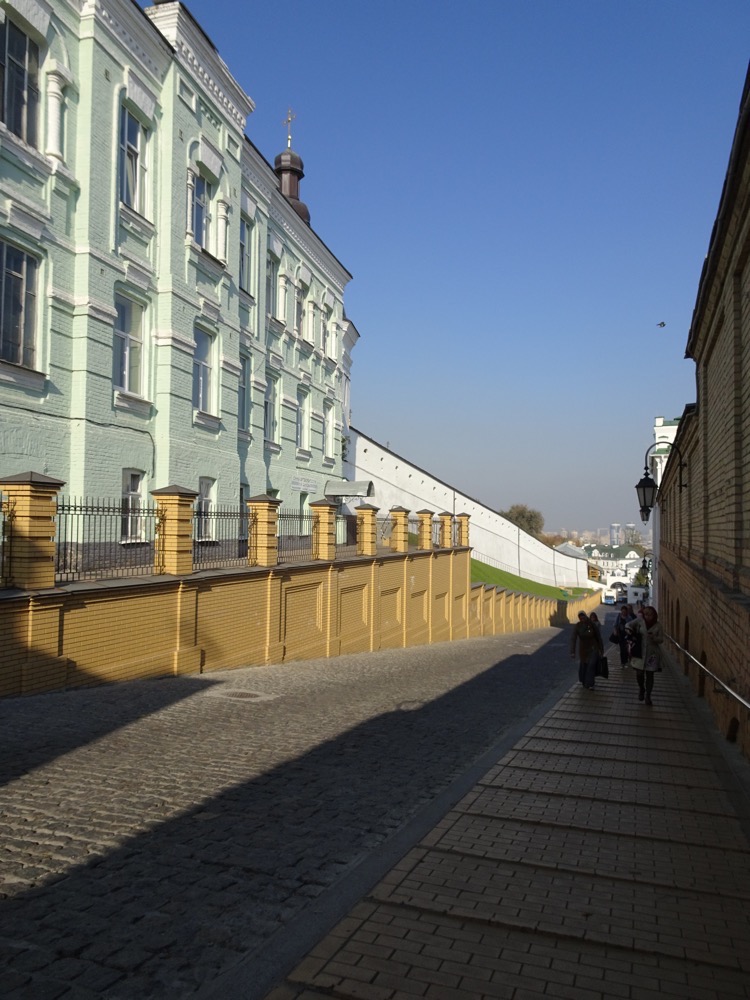 The caves are built into the hillside and are touted as being ‘catacombs’. But if you have ever seen any catacombs in Paris or Rome or somewhere, this place is completely different – it is a series of small paved and stuccoed tunnels connecting some rooms where the relics of saints have been preserved.
The caves are built into the hillside and are touted as being ‘catacombs’. But if you have ever seen any catacombs in Paris or Rome or somewhere, this place is completely different – it is a series of small paved and stuccoed tunnels connecting some rooms where the relics of saints have been preserved.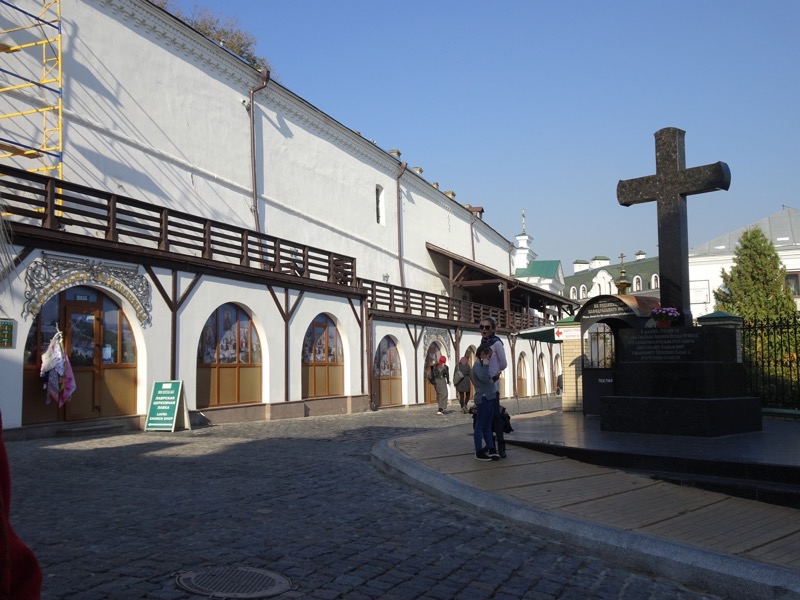 No photos allowed in the caves at Lavra, just plenty of noisily praying pilgrims. It is said that every Eastern Orthodox adherent should come to the caves of Lavra at least once in their lifetime. The dehydrated preserved relics of the ‘saints” reminded me of somewhere else I had seen a catacomb-like this – but I would have to go back through my travel photos to figure out where that was… St Petersberg maybe? Not sure.
No photos allowed in the caves at Lavra, just plenty of noisily praying pilgrims. It is said that every Eastern Orthodox adherent should come to the caves of Lavra at least once in their lifetime. The dehydrated preserved relics of the ‘saints” reminded me of somewhere else I had seen a catacomb-like this – but I would have to go back through my travel photos to figure out where that was… St Petersberg maybe? Not sure.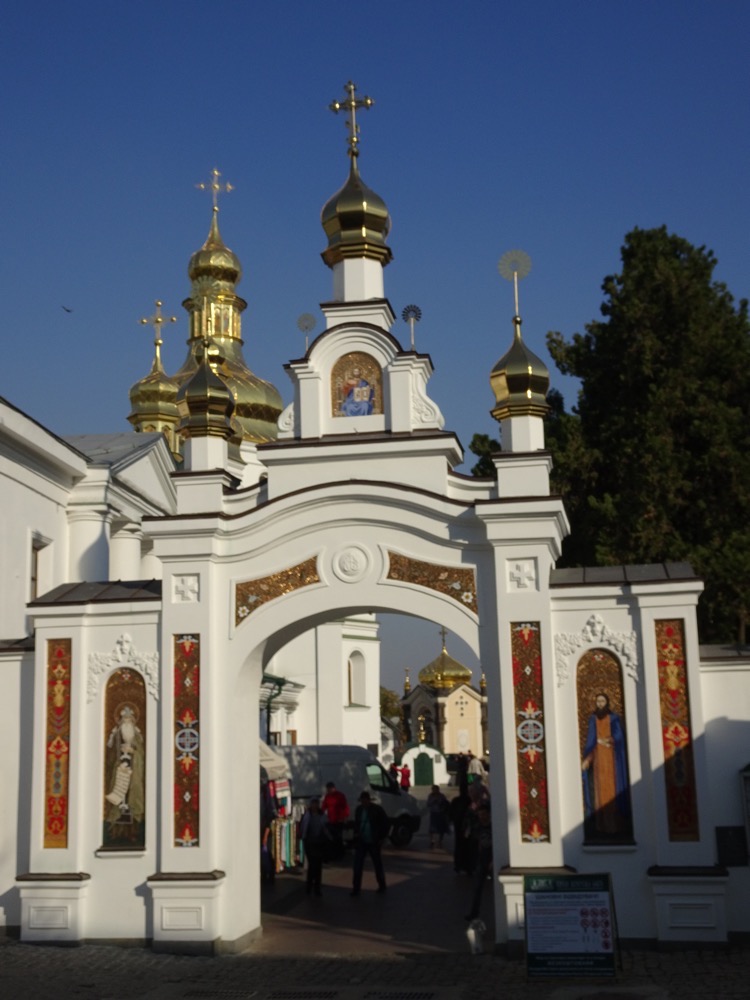
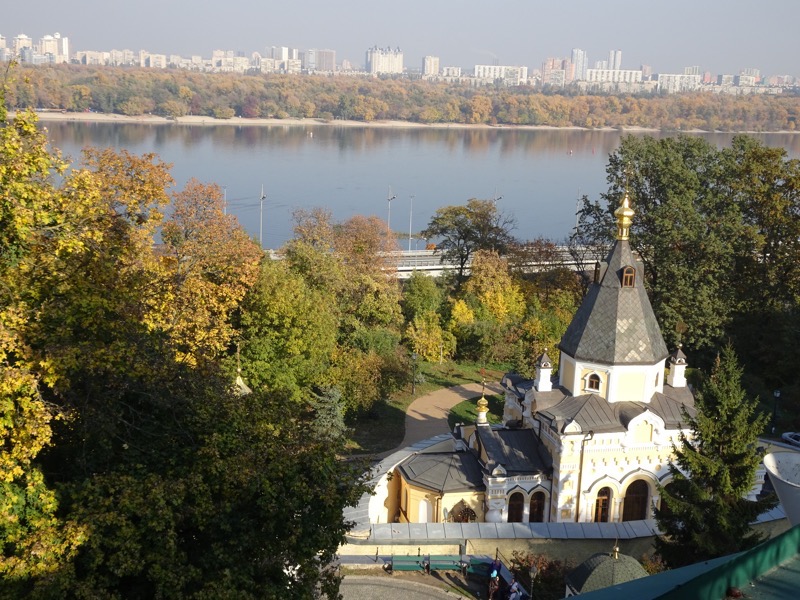
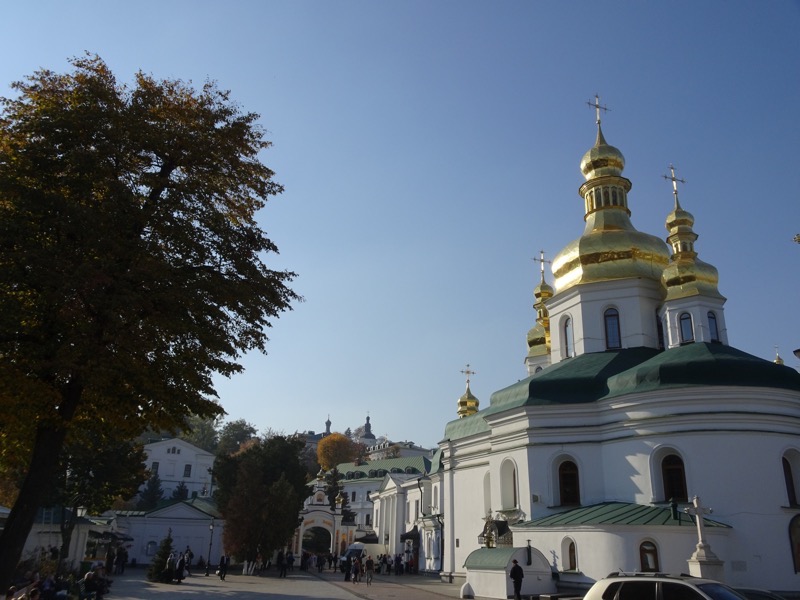
After our tour of the city, we went back to the hotel to rest my stupid back. I had made it through the itinerary without piking until we got to the last section of the Lavra Monastery and I looked at the hill and went, that’s a big ‘nope’. Seeing the Ukraine Hotel again after hearing its involvement in the recent uprisings – it looked different to me now, knowing that it had been used by the Soviet authorities as a sniper tower to quell the protesting population, made it less impressive and somewhat menacing. :/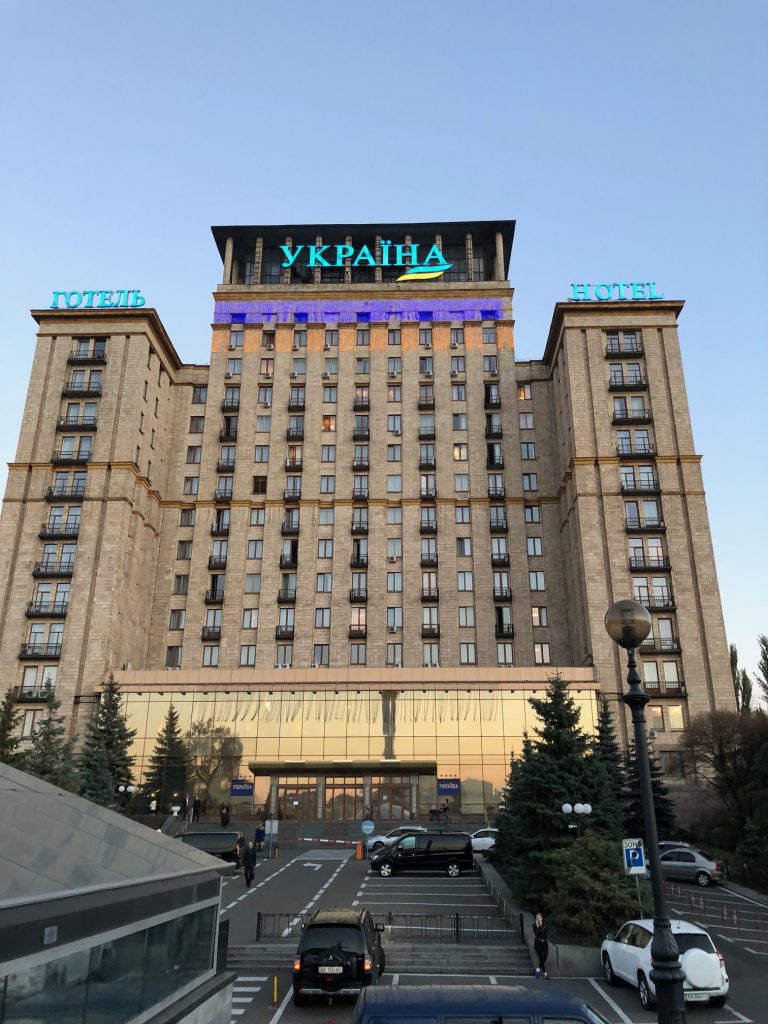 Another statue of the three founding brothers and their sister.
Another statue of the three founding brothers and their sister. 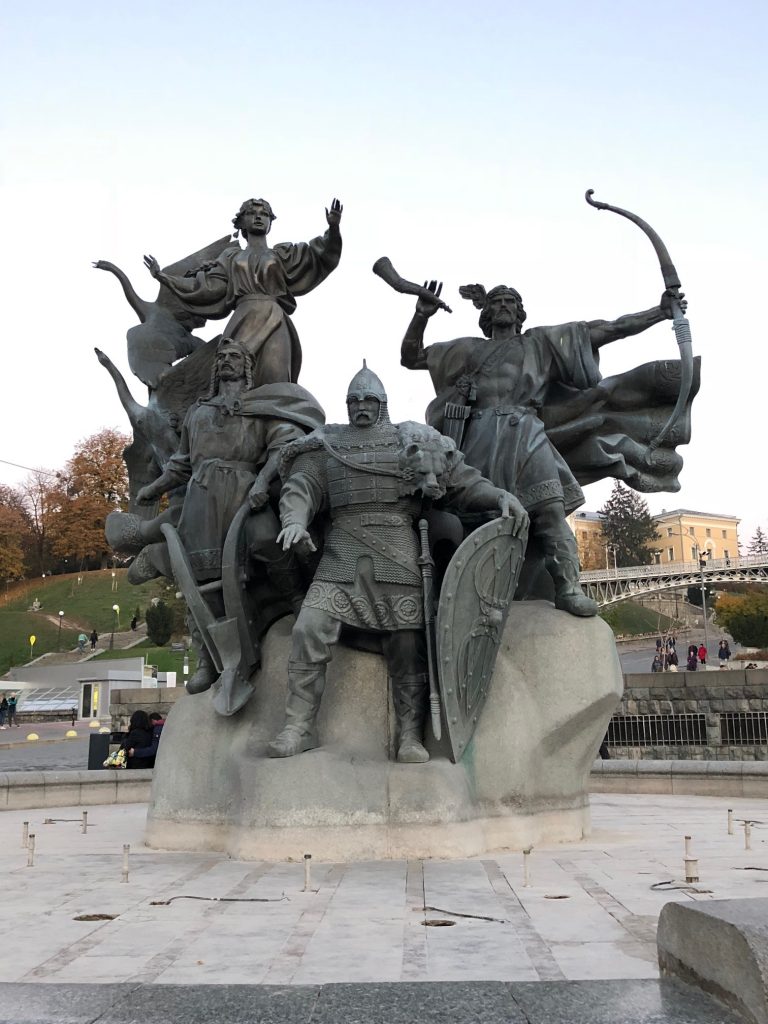 The main monument in Independence Square is the 62m victory Column of Independence. The figure atop the column is Berehynia, a national goddess or earth mother type. She holds a guelder rose branch which is the symbol of life, love and motherland. Some people love it, some people hate it apparently.
The main monument in Independence Square is the 62m victory Column of Independence. The figure atop the column is Berehynia, a national goddess or earth mother type. She holds a guelder rose branch which is the symbol of life, love and motherland. Some people love it, some people hate it apparently.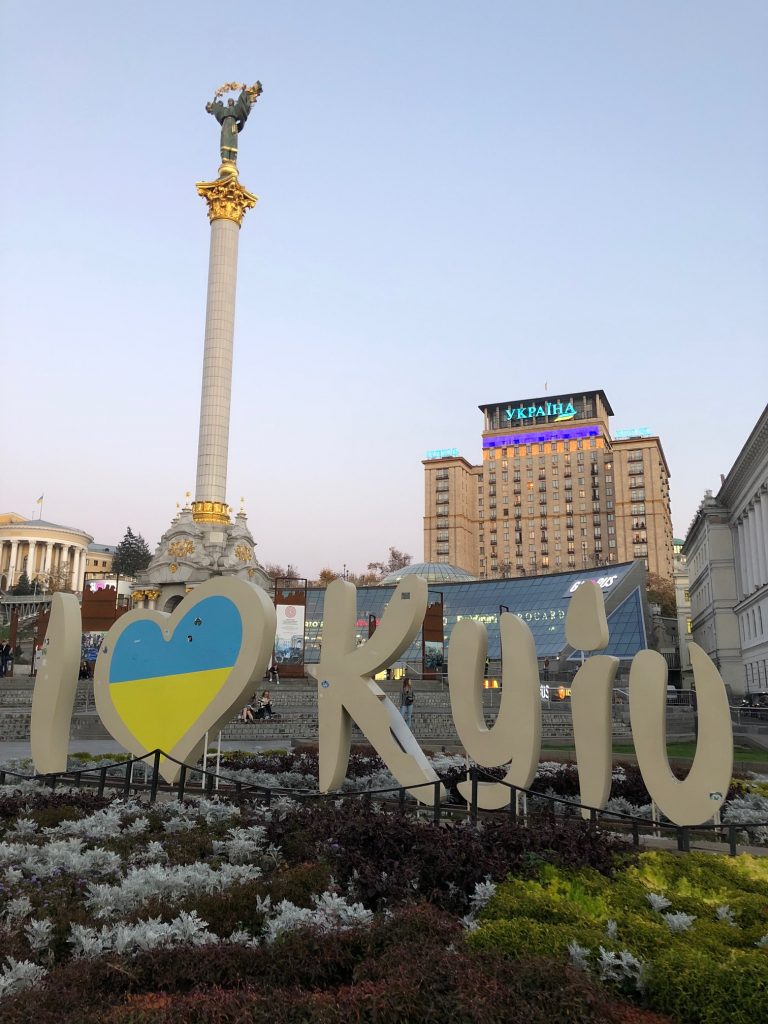 We had asked our guide earlier where to go for dinner and she recommended a restaurant called ‘Chicken Kyiv’… really – that is what the restaurant was called. We were seated and presented with menus that looked as thick as a bible!
We had asked our guide earlier where to go for dinner and she recommended a restaurant called ‘Chicken Kyiv’… really – that is what the restaurant was called. We were seated and presented with menus that looked as thick as a bible!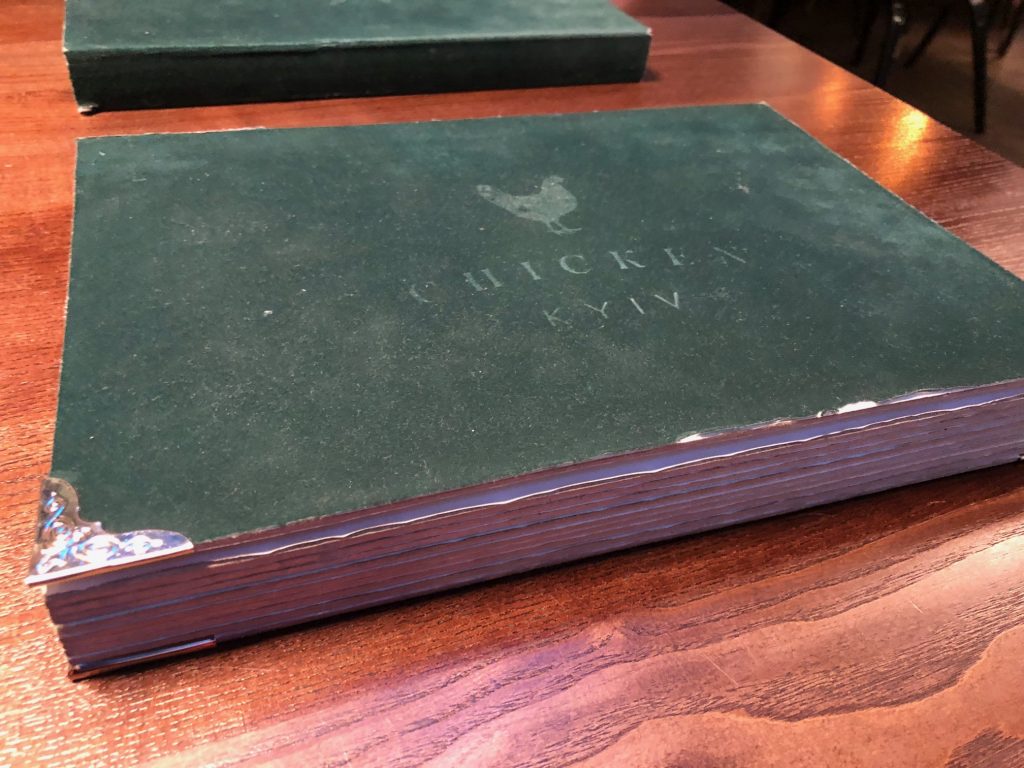 Only it turned out they were coreflut pop up books! Cute. Food was cheap and plenty of options.
Only it turned out they were coreflut pop up books! Cute. Food was cheap and plenty of options.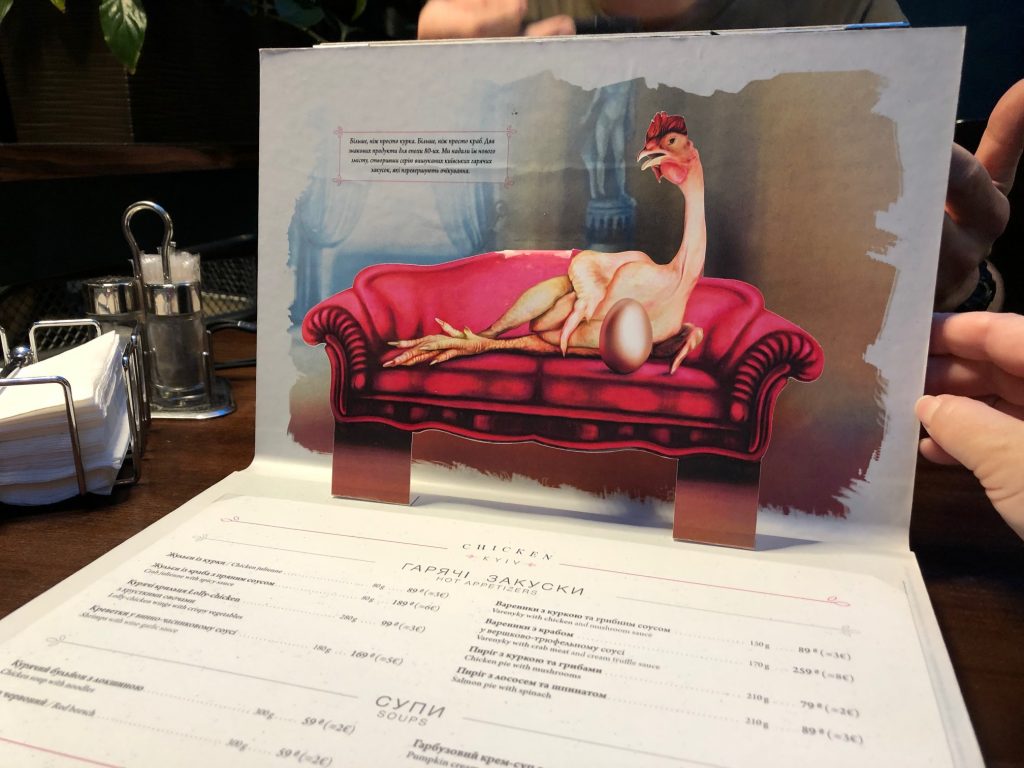 yale tried the chicken and mushroom tart for a starter which was very tasty…
yale tried the chicken and mushroom tart for a starter which was very tasty…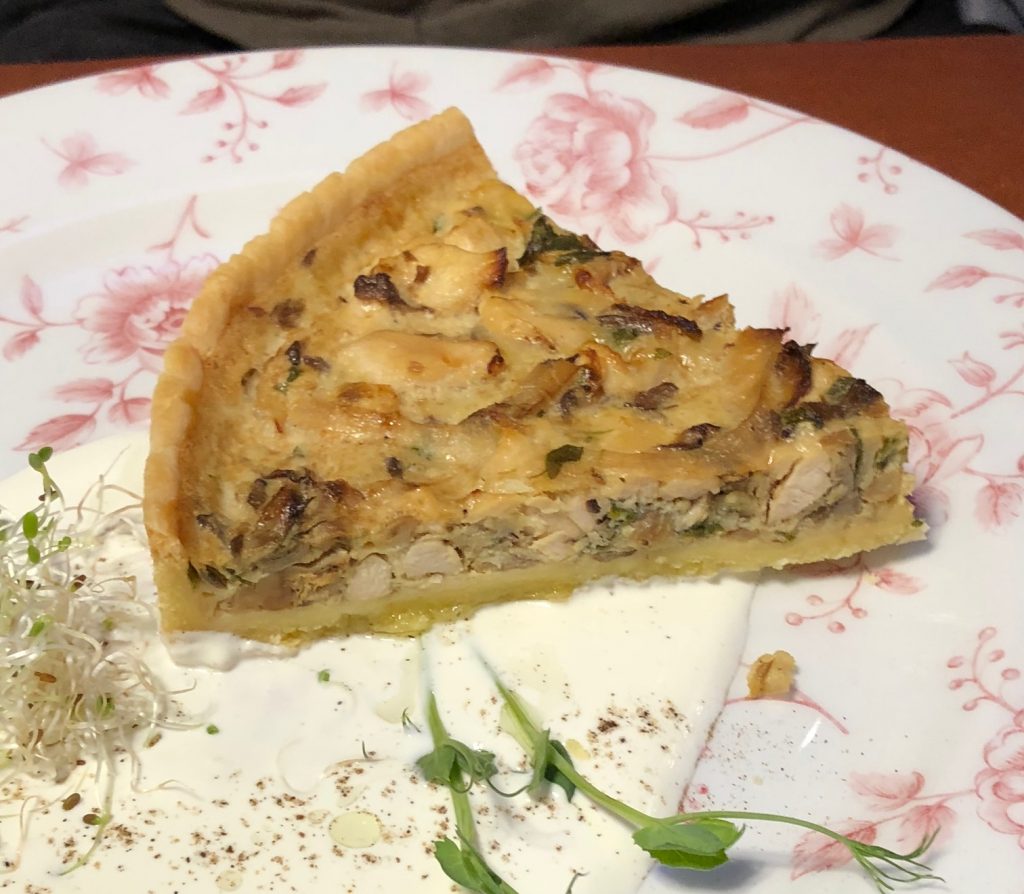 And I splashed out and ordered the sturgeon caviar (which turned out to be a quarter of the entire price of our bill). It was so totally worth it – absolultely delicious.
And I splashed out and ordered the sturgeon caviar (which turned out to be a quarter of the entire price of our bill). It was so totally worth it – absolultely delicious.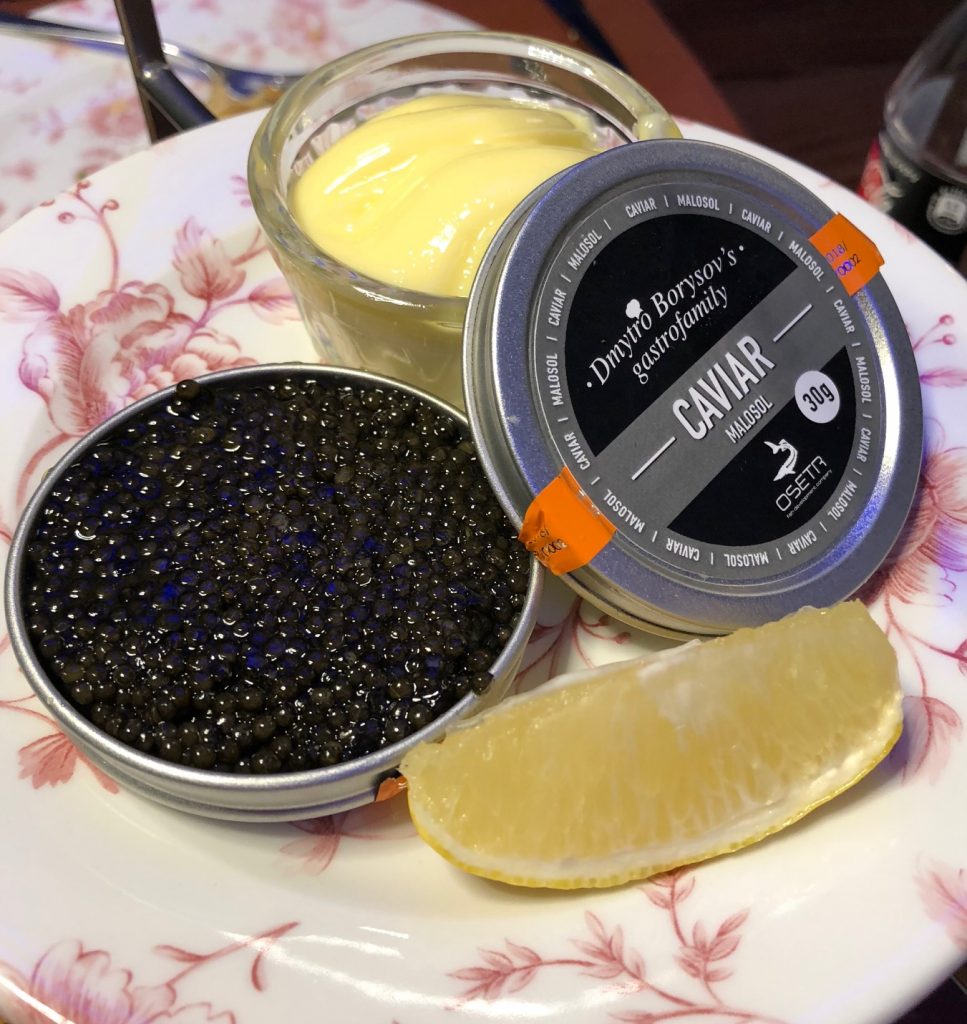 For mains, we tried their signature dish – when in Rome and all that – and ordered the Chicken Kyiv. It was a little disappointing to be honest, loaded with dill rather than the garlicky goodness we were expecting, it wasn’t exactly a taste sensation, but by the time we had put away a few more vodkas we didn’t really care.
For mains, we tried their signature dish – when in Rome and all that – and ordered the Chicken Kyiv. It was a little disappointing to be honest, loaded with dill rather than the garlicky goodness we were expecting, it wasn’t exactly a taste sensation, but by the time we had put away a few more vodkas we didn’t really care.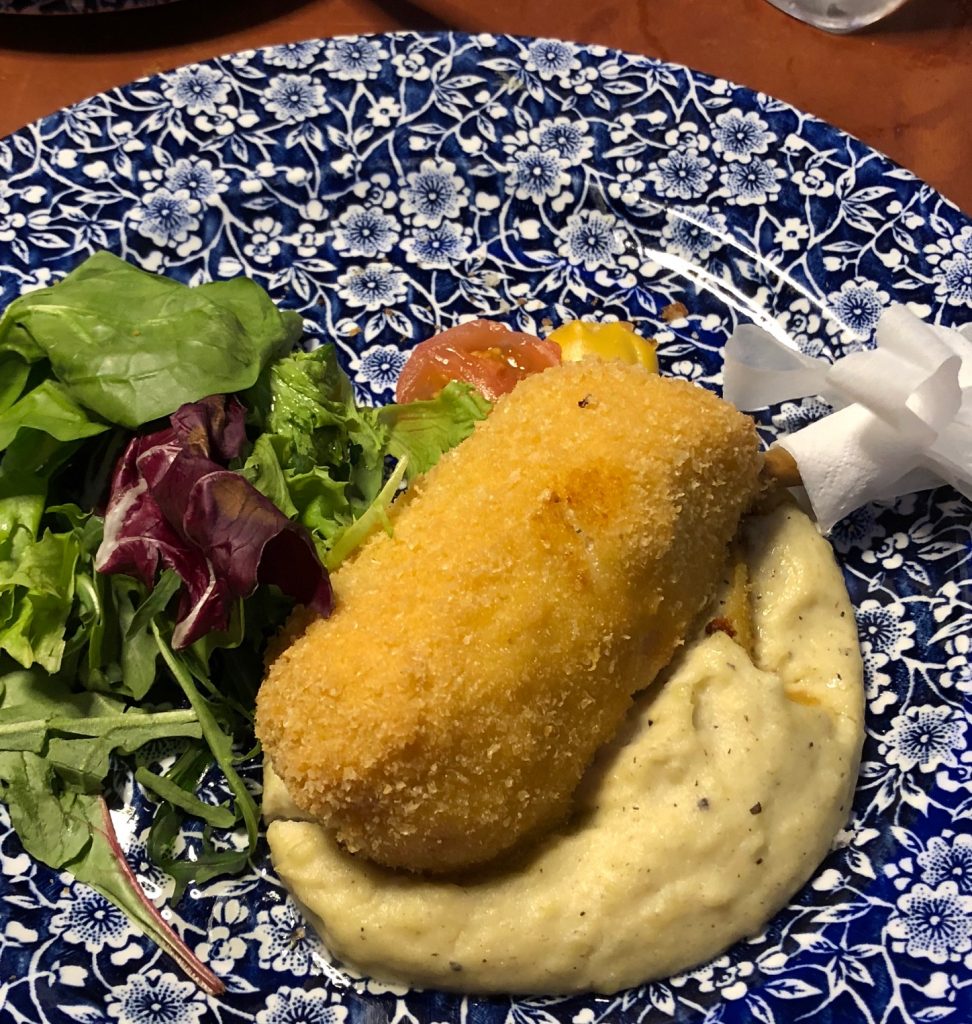 For dessert – proper honey cake! It was so good.
For dessert – proper honey cake! It was so good.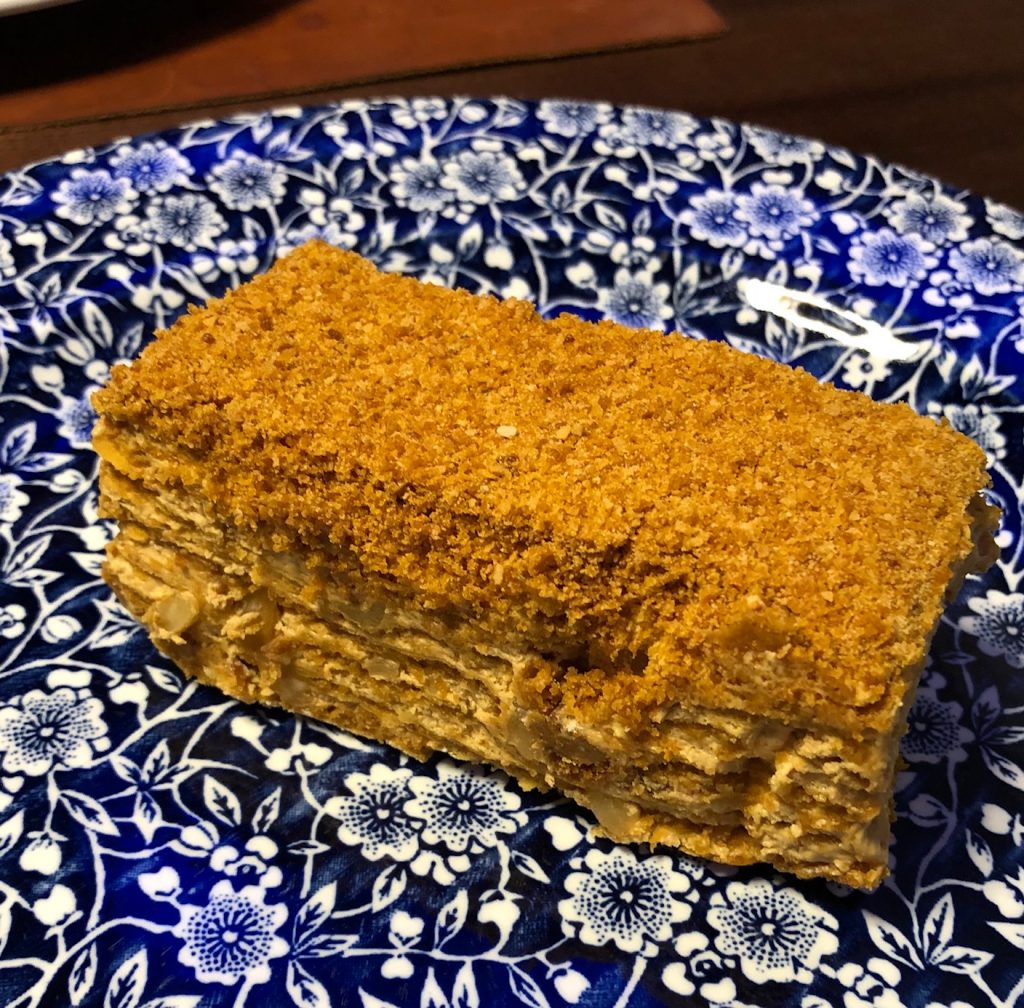 And yale had a Kiev cake – some sort of meringue and chocolate and pistachio concoction… but he liked my honey cake so much he went and ordered one of those as well.
And yale had a Kiev cake – some sort of meringue and chocolate and pistachio concoction… but he liked my honey cake so much he went and ordered one of those as well.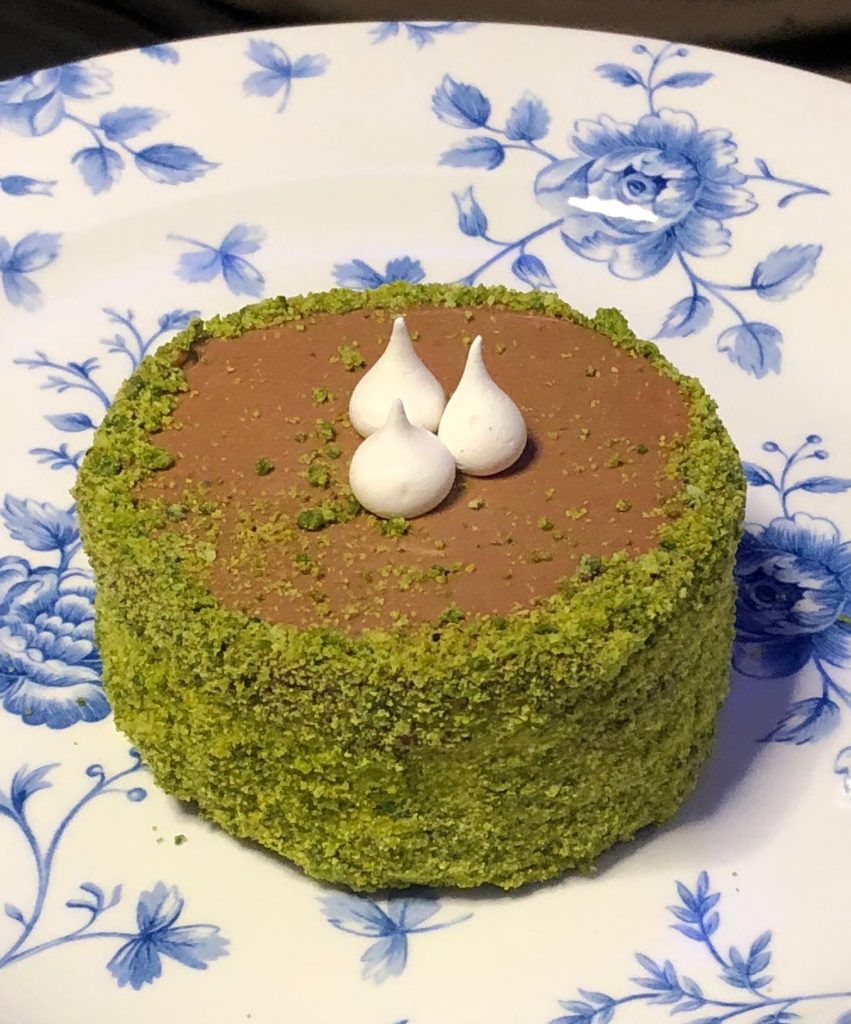 Throughout the meal we worked out way down the vodka menu starting at the top – drinks were so cheap we just kept ordering the next one down the list… and we made a pretty good dent in it, if I sawy so myself.
Throughout the meal we worked out way down the vodka menu starting at the top – drinks were so cheap we just kept ordering the next one down the list… and we made a pretty good dent in it, if I sawy so myself.
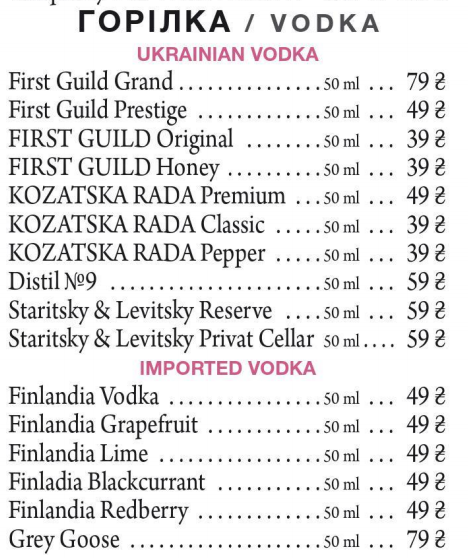
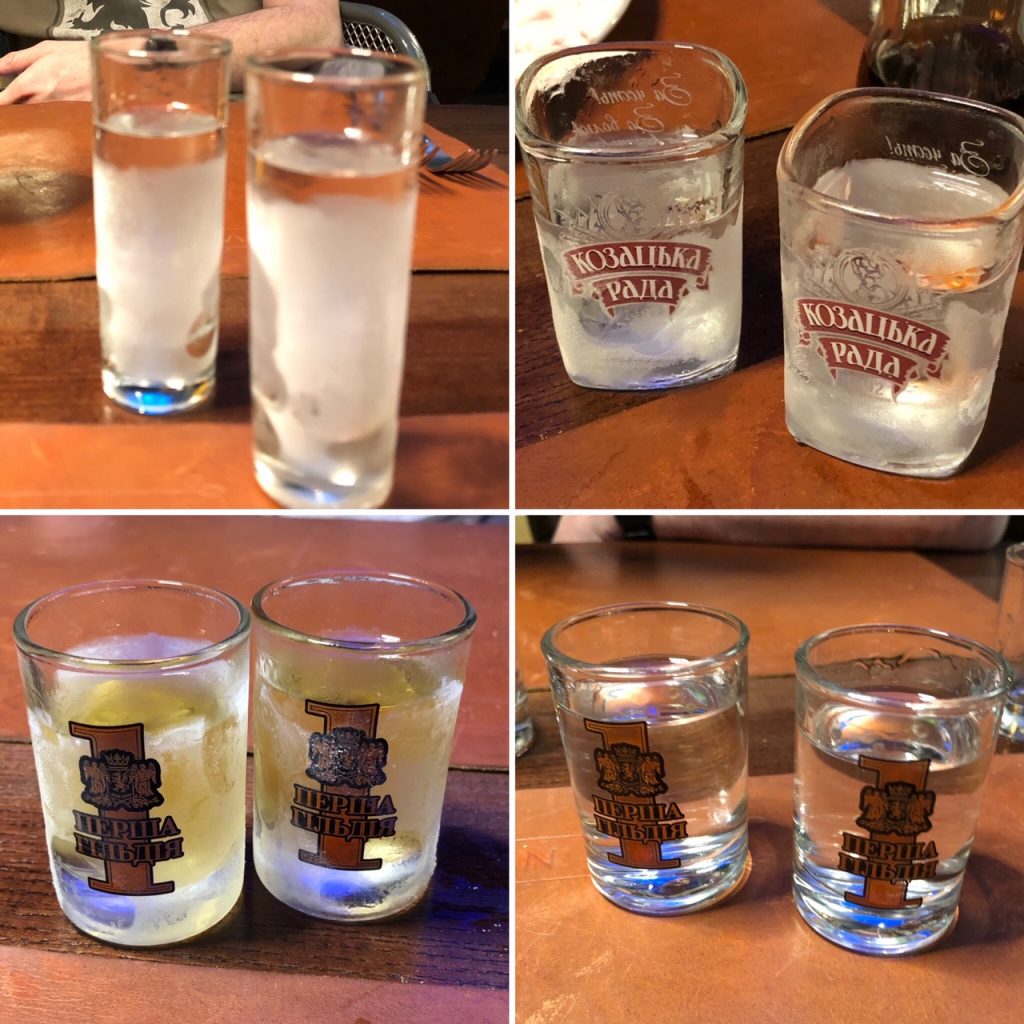 All up our dinner – three courses each including the ludicrously expensive caviar at (€27 for 30gms), plus about 12 vodkas was barely AUD$100. Woo-hoo! We’re not in Iceland anymore, Toto! Gotta love that exchange rate in Eastern Europe!
All up our dinner – three courses each including the ludicrously expensive caviar at (€27 for 30gms), plus about 12 vodkas was barely AUD$100. Woo-hoo! We’re not in Iceland anymore, Toto! Gotta love that exchange rate in Eastern Europe!
We stumbled and laughed our way back to the hotel, via a supermarket to pick up more alcohol, of course. We picked up a few things and at the checkout, three rather average Ukrainian men roughly about 5’8″ – 5’10”, but you know, stocky Ukrainian types came to line up behind us and started immediately commenting on Yale’s height (for those that don’t know him, he’s 6’9″. Naturally, we couldn’t understand what they were saying but with all the gesturing it was really obvious they were remarking how ridiculously tall he is, and of course standing beside him at 5’1″ (on a good day) I look equally ridiculous. It seemed in good natured and we weren’t feeling outnumbered or threatened at all, so as we made our purchase and as they moved to the register, yale started walking towards me, and I moved aside from him and put up two fingers about ten inches apart and winked at these guys, before turning on my heel and walking off. These poor guys fucking lost it! It was hilarious. 🙂 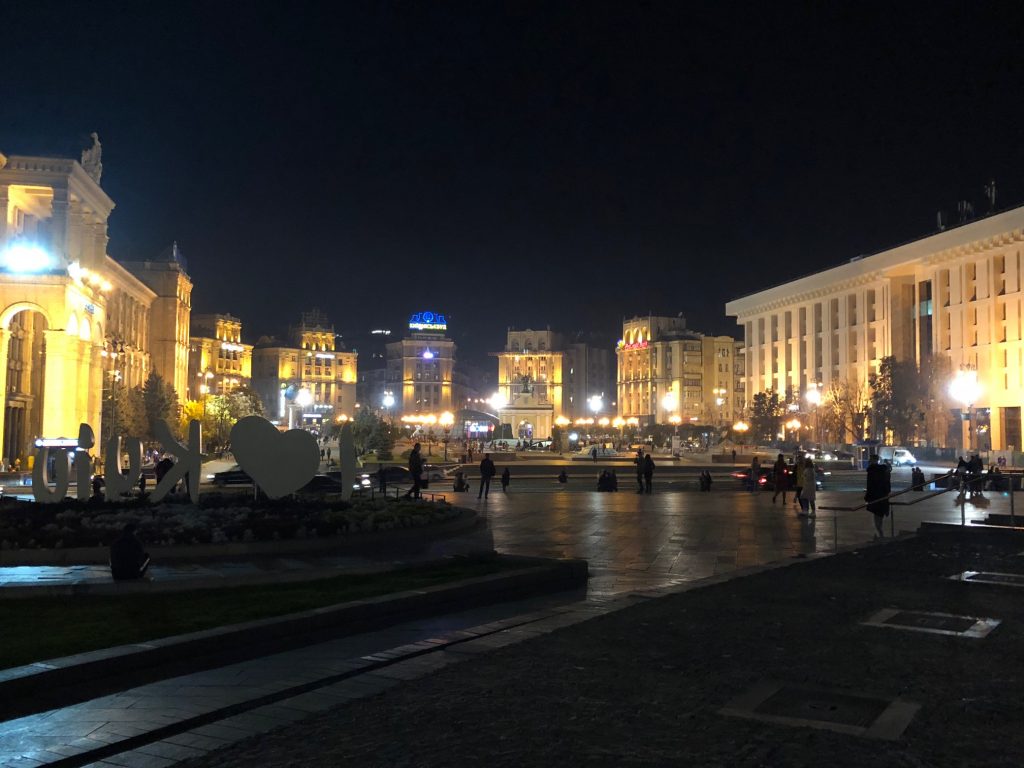
All up another great day out and a lovely evening, even though it was supposed be a lighter day than yesterday! Tomorrow, tomorrow will be a lighter day! *looks skywards*
